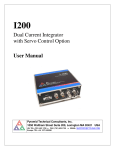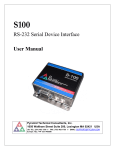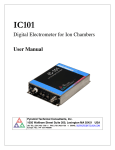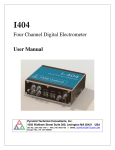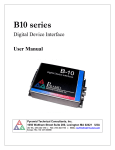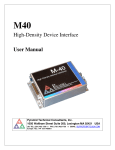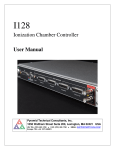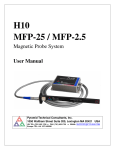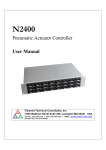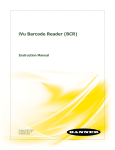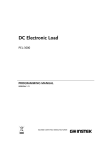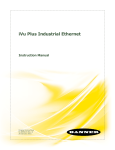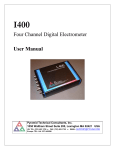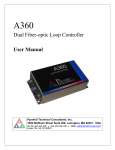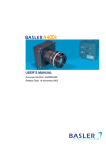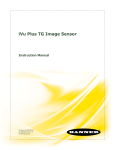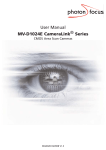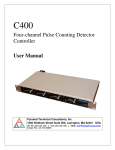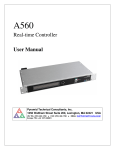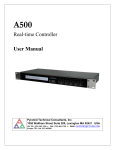Download Integrated Faraday Cup Controller User Manual
Transcript
F100 Integrated Faraday Cup Controller User Manual Pyramid Technical Consultants, Inc. 1050 Waltham Street Suite 200, Lexington MA 02421 USA US: TEL: (781) 402 1700 ♦ FAX: (781) 402-1750 ♦ EMAIL: [email protected] Europe: TEL: +44 1273 492001 PSI System Controls and Diagnostics 1 Contents 1 Contents ..............................................................................................................................................................2 2 Table of Figures ..................................................................................................................................................6 3 Safety Information .............................................................................................................................................8 4 Models ...............................................................................................................................................................10 5 Scope of Supply ................................................................................................................................................11 6 Optional Items ..................................................................................................................................................12 7 6.1 Power supplies ..............................................................................................................................................12 6.2 Signal cables and cable accessories .............................................................................................................12 6.3 High voltage and accessory cables ...............................................................................................................12 6.4 Data cables....................................................................................................................................................12 6.5 Fiber-optic loop ............................................................................................................................................12 Intended Use and Key Features ......................................................................................................................13 7.1 Intended use ..................................................................................................................................................13 7.2 Key features ...................................................................................................................................................14 8 Specification......................................................................................................................................................15 9 Installation ........................................................................................................................................................19 9.1 Mounting .......................................................................................................................................................19 9.2 Grounding and power supply ........................................................................................................................19 9.3 Connection to signal source ..........................................................................................................................20 9.3.1 Typical setup ........................................................................................................................................20 9.3.2 Signal cables ........................................................................................................................................21 9.3.3 Signal current path ...............................................................................................................................21 9.3.4 Summing input .....................................................................................................................................22 F100 User Manual F100_UM_140307 Page 2 of 95 PSI System Controls and Diagnostics 9.3.5 Loopback test current path ...................................................................................................................22 9.3.6 Protection diodes .................................................................................................................................23 10 Getting Started in ASCII Mode ......................................................................................................................25 11 Getting Started using the PSI Diagnostic Host Program..............................................................................29 11.1 Installing the PSI Diagnostic program .....................................................................................................29 11.1.1 Data tab ...........................................................................................................................................32 11.1.2 Setup tab..........................................................................................................................................34 11.1.3 Device tab .......................................................................................................................................37 12 USB Installation ...............................................................................................................................................40 13 Principle of Operation .....................................................................................................................................44 14 15 16 13.1 Current to voltage converters ...................................................................................................................44 13.2 F100 circuit overview ...............................................................................................................................45 13.3 Frequency response ..................................................................................................................................47 13.3.1 Data flow and filtering ....................................................................................................................47 13.3.2 Analog filtering ...............................................................................................................................48 13.3.3 Digital filtering ................................................................................................................................48 13.3.4 Filtering in the PSI Diagnostic host software ..................................................................................49 Measuring Currents .........................................................................................................................................50 14.1.1 Current ranges .................................................................................................................................50 14.1.2 Autoranging.....................................................................................................................................51 14.1.3 Triggering, trigger points and measurement timing ........................................................................52 14.1.4 Trigger sources................................................................................................................................52 Calibration ........................................................................................................................................................54 15.1 Why do we need calibration? ...................................................................................................................54 15.2 Gain calibration process ..........................................................................................................................54 High Voltage Supply ........................................................................................................................................55 16.1 Setting the high voltage ............................................................................................................................55 16.2 High voltage options.................................................................................................................................56 F100 User Manual F100_UM_140307 Page 3 of 95 PSI System Controls and Diagnostics 17 18 Auxiliary I/O .....................................................................................................................................................58 17.1 Switched 24 V output (-ACT option).........................................................................................................58 17.2 Opto-coupled inputs (-ACT option) ..........................................................................................................58 17.3 Digital outputs ..........................................................................................................................................59 Connectors ........................................................................................................................................................61 18.1 18.1.1 Optical gate input ............................................................................................................................61 18.1.2 Auxiliary I/O ...................................................................................................................................61 18.1.3 Signal input .....................................................................................................................................62 18.1.4 Auxiliary HV out.............................................................................................................................62 18.1.5 Ground lug ......................................................................................................................................62 18.2 19 Front panel connectors.............................................................................................................................61 Rear panel connectors ..............................................................................................................................63 18.2.1 Power input .....................................................................................................................................63 18.2.2 USB communications ......................................................................................................................63 18.2.3 RS-232 communications .................................................................................................................63 18.2.4 Fiber-optic communications ............................................................................................................63 Controls and Indicators ...................................................................................................................................64 19.1 Front panel controls .................................................................................................................................64 19.2 Rear panel controls ..................................................................................................................................64 19.2.1 Mode switch ....................................................................................................................................64 19.2.2 Address switch ................................................................................................................................65 19.3 Front panel indicators ..............................................................................................................................65 19.3.1 19.4 HV on ..............................................................................................................................................65 Rear panel indicators ...............................................................................................................................65 19.4.1 +24V ...............................................................................................................................................65 19.4.2 USB .................................................................................................................................................65 19.4.3 RS-232 ............................................................................................................................................65 19.4.4 Optical .............................................................................................................................................65 19.4.5 Xmit ................................................................................................................................................65 19.4.6 Rcv ..................................................................................................................................................65 19.4.7 Status ...............................................................................................................................................66 19.4.8 Link .................................................................................................................................................66 F100 User Manual F100_UM_140307 Page 4 of 95 PSI System Controls and Diagnostics 20 Communications Interfaces .............................................................................................................................67 21 Communications Protocols ..............................................................................................................................69 21.1 Overview ...................................................................................................................................................69 21.2 ASCII Protocol - SCPI..............................................................................................................................70 21.2.1 Messages .........................................................................................................................................70 21.2.2 Status registers ................................................................................................................................70 21.2.3 Host commands ...............................................................................................................................72 21.3 ASCII Protocol – terminal mode ..............................................................................................................79 21.4 Binary Protocol ........................................................................................................................................79 22 Software Updates .............................................................................................................................................80 23 Making Low Current Measurements .............................................................................................................82 23.1 Guarding and screening ...........................................................................................................................82 23.2 Temperature .............................................................................................................................................83 23.3 Triboelectric effects ..................................................................................................................................83 23.4 Battery effects ...........................................................................................................................................84 23.5 Currents in cooling water circuits ............................................................................................................84 23.6 Piezoelectric effects ..................................................................................................................................85 23.7 Averaging period and synchronization.....................................................................................................85 23.8 Summary ...................................................................................................................................................85 24 Fault-finding .....................................................................................................................................................87 25 Maintenance .....................................................................................................................................................91 26 Returns Procedure ...........................................................................................................................................92 27 Support..............................................................................................................................................................93 28 Declaration of Conformity ..............................................................................................................................94 29 Revision History ...............................................................................................................................................95 F100 User Manual F100_UM_140307 Page 5 of 95 PSI System Controls and Diagnostics 2 Table of Figures Figure 1. F100 chassis end panels ............................................................................................... 17 Figure 2. F100 case side and plan views (above). Dimensions mm ........................................... 18 Figure 3. Schematic F100 installation to read out a Faraday cup ................................................ 20 Figure 4. Path of measured current when measuring the current of a positive ion beam ............ 21 Figure 5. Summing input operating mode ................................................................................... 22 Figure 6. Calibration current loopback mode .............................................................................. 23 Figure 7. External diodes to prevent the Faraday cup collector charging to beam voltage if the F100 is removed .................................................................................................................... 24 Figure 8. RS232 connection cable from the F100 to a PC serial port (DB9). Pins are shown looking at the face of the connectors .................................................................................... 25 Figure 9. Hyperterminal COM port setup .................................................................................... 26 Figure 10. Hyperterminal terminal settings ................................................................................. 26 Figure 11. Example Hyperterminal session (terminal mode) ...................................................... 28 Figure 12. Direct RS-232 connection to the F100 ....................................................................... 30 Figure 13. Direct USB connection to the F100 ............................................................................ 30 Figure 14. PSI Diagnostic search utility....................................................................................... 31 Figure 15. Data/current tab: F100 running with default settings, showing background noise .... 32 Figure 16. F100 setup tab ............................................................................................................. 34 Figure 17. Setup tab for an F100 configured for dosimetry applications .................................... 36 Figure 18. Internal calibration current enabled on 1 mA range, strip chart display format ......... 37 Figure 19. Device tab, showing firmware update utility controls ................................................ 38 Figure 20. The basic I-V converter circuit ................................................................................... 44 Figure 21. F100 block schematic (-LB and –ACT options)......................................................... 45 Figure 22. F100 data flow and filtering ....................................................................................... 47 Figure 23. F100 analog frequency response (linear vertical scale). Red curve: after I-V converter. Green curve: after filter ....................................................................................... 48 Figure 24. F100 digital frequency response (linear vertical scale). The analog response and overall response are also plotted ........................................................................................... 49 Figure 25. Schematic illustration of a range change for the shortest averaging period ............... 51 Figure 26. Current compliance of the 1000V high voltage supplies............................................ 55 F100 User Manual F100_UM_140307 Page 6 of 95 PSI System Controls and Diagnostics Figure 27. Internal jumper settings for high voltage configuration ............................................. 57 Figure 28. Driving a remote 24 VDC solenoid ............................................................................ 58 Figure 29. Opto-coupler digital input connected to remote microswitch .................................... 59 Figure 30. Actuator interfacing .................................................................................................... 59 Figure 31. Digital outputs ............................................................................................................ 60 Figure 32. Lemo connector to mate with F100 input ................................................................... 62 Figure 33. Rear panel showing controls and indicators ............................................................... 64 Figure 34. SCPI Status register structure ..................................................................................... 71 Figure 35. Selecting the hex file to load ...................................................................................... 81 Figure 36. Upload in progress ...................................................................................................... 81 Figure 37. Background current due to voltage across an insulator .............................................. 82 Figure 38. Guarded input ............................................................................................................. 83 Figure 39. Indirect cooling to prevent background current from cooling water .......................... 84 F100 User Manual F100_UM_140307 Page 7 of 95 PSI System Controls and Diagnostics 3 Safety Information This unit is designed for compliance with harmonized electrical safety standard EN610101:2000. It must be used in accordance with its specifications and operating instructions. Operators of the unit are expected to be qualified personnel who are aware of electrical safety issues. The customer’s Responsible Body, as defined in the standard, must ensure that operators are provided with the appropriate equipment and training. The unit is designed to make measurements in Measurement Category I as defined in the standard. CAUTION The F100 can generate high voltages as follows, when the relevant option is specified: + or – 2000 V DC at 1 watt maximum. Present on the central conductor of the SHV connector for units with the high-voltage option. These voltages and currents are not classified as hazardous live under EN61010 but may nevertheless give a noticeable shock. The user must therefore exercise appropriate caution when using the device and when connecting cables. Power should be turned off before making any connections. In applications where high energy charged particle beams can strike electrodes which are normally connected to the F100, voltages limited only by electrical breakdown can build up if the F100 is not connected to provide the earth return path. The user must ensure that a suitable earth return path is always present when the particle beam may be present. The unit must not be operated unless correctly assembled in its case. Protection from high voltages generated by the device will be impaired if the unit is operated without its case. Only Service Personnel, as defined in EN61010-1, should attempt to work on the disassembled unit, and then only under specific instruction from Pyramid Technical Consultants. The unit is designed to operate from +24VDC power, with a maximum current requirement of 500mA excluding any current delivered to the actuator connector. A suitably rated power supply module is available as an option. Users who make their own power provision should ensure that the supply cannot source more than 1500mA. A safety ground must be securely connected to the ground lug on the case. Some of the following symbols may be displayed on the unit, and have the indicated meanings. F100 User Manual F100_UM_140307 Page 8 of 95 PSI System Controls and Diagnostics Direct current Earth (ground) terminal Protective conductor terminal Frame or chassis terminal Equipotentiality Supply ON Supply OFF CAUTION – RISK OF ELECTRIC SHOCK CAUTION – RISK OF DANGER – REFER TO MANUAL F100 User Manual F100_UM_140307 Page 9 of 95 PSI System Controls and Diagnostics 4 Models F100 Integrated Faraday collector controller with multi-range I-V conversion, ADC and communications channel to a host computer -XP20/10/5/2 Add positive 0 to 1000 V / 500 V / 200 V auxiliary bias output -XN20/10/5/2 Add negative 0 to 1000V /500 V / 200 V auxiliary bias output -IM200 Change maximum input current to 200 mA (default is 10 mA) -LB Add calibration current external loopback option (replaces default which is input summing) -ACT Add actuator control option Example: F100-XN10-IM200LB-ACT F100 User Manual F100 with 1000V negative auxiliary bias output, maximum current 200 mA, calibration loopback and actuator control. F100_UM_140307 Page 10 of 95 PSI System Controls and Diagnostics 5 Scope of Supply F100 model as specified in your order. PSU24-40-1 power supply. ADAP-D9F-MINIDIN serial connector adaptor. USB memory stick containing: User manual PSI Diagnostic installation files Firmware files USB drivers and utilities Test and calibration data OEM customers do not receive all accessories. Optional items as specified in your order. F100 User Manual F100_UM_140307 Page 11 of 95 PSI System Controls and Diagnostics 6 Optional Items 6.1 Power supplies PSU24-40-1 +24 VDC 1.8 A PSU (universal voltage input, plug receptacle for standard IEC 14 socket) with output lead terminated in 2.1mm threaded jack. 6.2 Signal cables and cable accessories CAB-L304-10-NT Cable, Lemo four-pin plug to bared ends, 10’. Other lengths available up to 100’. CAB-L304-10LN-NT Cable low-noise, Lemo four-pin plug to bared ends, 10’. Other lengths available up to 100’. 6.3 High voltage and accessory cables CAB-SHV-10-SHV Cable SHV to SHV, 10’. Other lengths available up to 100’. CAB-D9F-10-NT Cable, DSub 9 pin plug to bared ends, 10’, for actuator. Other lengths available up to 100’. 6.4 Data cables ADAP-D9F-MINIDIN RS-232 6 pin DIN male to 9 pin D sub female adaptor. CAB-ST-HCS-10-ST Fiber-optic cable pair 200 um silica fiber ST terminated with color-coded sleeves, 10’. Other lengths available up to 300’. 6.5 Fiber-optic loop A360 fiber-optic loop controller for two loops with Ethernet interface. A500 intelligent real-time cell controller for five or ten loops with Ethernet interface. A560 intelligent real-time cell controller for ten loops with Ethernet interface and interlock features. X22 Bidirectional Optical to TTL converter. X14 fiber optic fanout, one input, four outputs for trigger distribution. F100 User Manual F100_UM_140307 Page 12 of 95 PSI System Controls and Diagnostics 7 Intended Use and Key Features 7.1 Intended use The F100 is intended for the measurement of currents (from nA to mA) generated by devices such as Faraday cups. Sensors which produce similar current levels, such as ionization chambers, in-vacuum beam position monitors, and photodiodes can also be attached. The default application is real-time dosimetry. The F100 accumulates the incoming current, and changes the state of a digital logic output when a pre-determined dose has been reached. It also generates a monitor pulse each time a defined aliquot of charge is measured. If this type of dosimetry is not required, then the relevant I/O connector becomes available for pneumatic actuator control (-ACT option). The F100 can be supplied with an auxiliary high-voltage output, appropriate for electrical suppression of secondary electrons in Faraday cup assemblies. Optional auxiliary I/O allows a pneumatic actuator switched by +24 VDC to be controlled, and two motion limit switches to be read back. The F100 has design features which make it tolerant of electrically noisy environments, but the place of use is otherwise assumed to be clean and sheltered, for example a laboratory or light industrial environment. The unit may be used stand-alone, or networked with other devices and integrated into a larger system. Users are assumed to be experienced in the general use of precision electronic circuits for sensitive measurements, and to be aware of the dangers that can arise in high-voltage circuits. F100 User Manual F100_UM_140307 Page 13 of 95 PSI System Controls and Diagnostics 7.2 Key features Highly sensitive current measuring system. Four I-V converter ranges plus programmable gain amplifier stage to give sixteen current ranges (thirteen unique ranges) Built-in 250 kHz ADC. On-board digital signal averaging with configurable integration period. Automatic or manual range change. Dynamic range 100 pA to 10 mA with standard feedback resistors, bipolar. Option to make the maximum measureable current 200 mA. Built-in calibration current source, automated self-calibration with on-board storage of calibration parameters. Relay summing input. Optional calibration current loopback feature (alternative to relay summing input) allows external circuit to be validated. External gate input for triggered measurements. Optional control and readback for a pneumatic actuator (+24 VDC). RS-232, USB and fast fiber-optic serial interfaces built-in. Selectable baud rates. Can be operated in a fiber-optic serial communication loop with up to fourteen other devices. 100BaseT Ethernet available through the A360, A560 and A500 products. ASCII and binary serial data formats. Auxiliary HV output option up to + or – 2000 VDC. F100 User Manual F100_UM_140307 Page 14 of 95 PSI System Controls and Diagnostics 8 Specification Inputs One, bipolar Summing Internal relay can connect two input pins to provide summing of two currents (not available if calibration current loopback feature is installed) Input protection Back to back diodes limit input to +/- 0.6V 1 kohm series input inside feedback loops limit current to I-V converter amplifiers Input impedance < 1 ohm while operating within specified current range I-V converter stages Four, feedback resistors 1k, 10k, 100k, 1M (standard feedback resistor option) Input noise > 0.01% of full scale rms noise for 10 mA, 1 mA, 100 uA, 10 uA ranges (standard resistors) External accuracy Readings within +/- (0.07% of nominal reading + 0.03% of full scale) relative to a traceable external standard current source Stability Output drift < 5 ppm / C / hour Digitization 16 bit over +/- input current range, 250 kHz. Linearity Deviation from best fit line of individual readings < 0.1% of maximum current on any given range Range to range consistency A current that is 80% of the full scale of a given range will be read to within +/- 0.1% on the next higher range Drift < 0.5% over 12 hours Auxiliary HV PSU (option) 0 to 2000/1000/500/200 V programmable via 16 bit DAC, 1 watt maximum output Noise and ripple <0.1% of full scale External gate (optical) Phototransistor (HFBR 1528) suitable for 650 nm light Measurement start modes Internal ExternalStart: start signal on gate input ExternalStartStop: start and stop on gate input ExternalGated: gate input controls integrators directly Message: start on special message on communication loop Communications Fiber optic (10 Mbit/sec) USB (3 Mbit/sec) RS-232 (115 kbit/sec max) F100 User Manual F100_UM_140307 Page 15 of 95 PSI System Controls and Diagnostics Power input +24 VDC (+/-2 V), 350 mA typical, 500 mA maximum excluding external actuator drive Case Stainless steel Case protection rating The case is designed to rating IP43 (protected against solid objects greater than 1mm in size, protected against spraying water) Weight 0.33 kg (0.73 lb) Operating environment 0 to 35 C (15 to 25 C recommended to reduce drift and offset) < 70% humidity, non-condensing vibration < 0.1g all axes (1 to 100Hz) Shipping and storage environment -10 to 50C < 80% humidity, non-condensing vibration < 2 g all axes, 1 to 100 Hz Dimensions (see figures 1 and 2) F100 User Manual F100_UM_140307 Page 16 of 95 PSI System Controls and Diagnostics ACTUATOR SIGNAL GATE HV OUT (SHV) "HV ON" LED HV RS-232 USB FIBER-OPTIC TX FIBER-OPTIC RX STATUS LEDs +24VDC POWER IN +24V M3 GROUND LUG USB RS-232 Optical Xmit Rcv Mode COMMS SELECTOR Status Link Address ADDRESS SELECTOR Figure 1. F100 chassis end panels F100 User Manual F100_UM_140307 Page 17 of 95 PSI System Controls and Diagnostics 4X Ø3.66 MOUNTING HOLE 2X 161.3 167.7 164.4 2X 144.0 8.6 2X 152.0 161.1 4.5 140.8 52.7 0.9 2X 10.2 170.3 Figure 2. F100 case side and plan views (above). Dimensions mm F100 User Manual F100_UM_140307 Page 18 of 95 PSI System Controls and Diagnostics 9 Installation 9.1 Mounting The F100 may be mounted in any orientation, or may be simply placed on a level surface. A fixed mounting to a secure frame is recommended in a permanent installation for best low current performance, as this can be degraded by movement and vibration. Four M3 clearance holes are provided in the base flange on a 152 mm by 144 mm rectangular pattern (see figure 2). The mounting position should allow sufficient access to connectors and cable bend radii. Leave 100mm clearance at either end for mating connectors and cable radii. Best performance will be achieved if the F100 is in a temperature-controlled environment. No forced-air cooling is required, but free convection should be allowed around the case. 9.2 Grounding and power supply A secure connection should be made using a ring lug, from the M3 ground lug to local chassis potential. This is the return path for any high voltage discharge passing via the F100. +24 VDC power should be provided from a suitably-rated power supply with the following minimum performance: Output voltage +24 +/- 0.5 VDC Output current 1000 mA minimum, 2000 mA maximum Ripple and noise < 100 mV pk-pk, 1 Hz to 1 MHz Line regulation < 240 mV The F100 includes an internal automatically re-setting PTC fuse rated at 1.1 A. However the external supply should in no circumstances be rated higher than the F100 connector limit of 5 A, and a maximum of 2.0 A is recommended. F100 User Manual F100_UM_140307 Page 19 of 95 PSI System Controls and Diagnostics 9.3 Connection to signal source 9.3.1 Typical setup Figure 3 shows a typical Faraday cup installation in schematic form. Two connections are made to the collector electrode, the connection to the F100 input and the calibration current test output. This allows the continuity and isolation of the external circuit to be tested. When the calibration current is routed to this output, it should pass onto the collector. A suppression electrode is biased negative by the auxiliary external output to prevent electrons escaping from the cup, and thereby degrading accuracy. Pneumatic actuator with limit switches Test F100 Comms Sig Rtn +24V in Suppression voltage Figure 3. Schematic F100 installation to read out a Faraday cup Refer to section 23 in this manual for general guidance on making low current measurements. The F100 should be located as close to the source of the signal as possible. Long signal cables increase the chances of seeing unwanted signals and noise. A maximum length of 10 m/ 33’ is advised. Longer cables may be used, but the lowest detectable current will be increased. Pyramid Technical Consultants, Inc. does not recommend using the direct USB interface for very low current measurements. Connecting the USB cable causes the chassis to connect to analog ground in the F100, which increases zero noise and drift. Fiber-optic interfacing is optimum for both speed and noise immunity. F100 User Manual F100_UM_140307 Page 20 of 95 PSI System Controls and Diagnostics 9.3.2 Signal cables Good-quality screened four-core cable should be used, terminated in a type 0B four-pin on Lemo plug at the F100 end. If you are measuring currents at the bottom end of the dynamic range, then we recommend using low-noise anti-triboelectric cable. The connection at the sensor end can be varied according to your needs – it may be a coaxial connector, or simply ring lugs for direct attachment to convenient points. The minimum requirement is to connect the signal in (pin 1) and return (pin 2) lines. If you want to use the input summing or calibration current loopback features, you should also connect pin 3 to the sensor appropriately. The fourth core is F100 chassis potential. Normally this is left unconnected at the sensor end, but in some situations you may get better noise performance if it is connected to a ground screen at the sensor end also. 9.3.3 Signal current path Figure 4 illustrates how the current you are measuring passes along the signal conductor to the F100 input, taking the example of a beamline with a positive ion source and a Faraday cup. The situation with electrons or negative ions is analogous, but with reversed direction of conventional current. The F100 can measure conventional current flowing into or out of its input. It is important that the current return circuit is continuous, or you will not measure correctly or even at all, despite a beam arriving at the collector. Beamline Ion source Cable F100 Faraday cup 4 M+ 3 e- 1 2 HV PSU Suppression HV 1 2 3 4 Signal Return Screen Figure 4. Path of measured current when measuring the current of a positive ion beam A current of positive ions is extracted from an ion source by the potential of a high voltage power supply. A corresponding current must flow from the supply. The ions are collected by the Faraday cup. Secondary electrons released from the surface of the cup are prevented from escaping (and thus rendering the monitored current inaccurate) by the suppression fields, which can be electrostatic, magnetic, or a combination of both. F100 User Manual F100_UM_140307 Page 21 of 95 PSI System Controls and Diagnostics The positive charge arriving at the cup is compensated by a flow of electrons along the cable from the F100, which is a conventional current into the F100. A current must flow from the F100 to balance this input, and this flows to the body of the beamline via the return wire. Finally it returns to the HV power supply via ground. Note that it is possible for the return current path to be via the F100 chassis and general ground. However this is not a reliable path, so you should always make a definite connection from pin 2 of the F100 signal connector to the beamline ground near the Faraday cup, as shown in the figure. 9.3.4 Summing input Pin 3 on the signal input connector is connected to an internal relay. In the default summing input version of the F100, this relay connects pin 3 to the normal signal input pin 1 when it is closed, thus summing the currents on the two pins into the amplifier input. A typical application is where the signal collecting electrode is divided into two pads, and you either want to take signal from one pad, for example a small pad that measures local current density, or from both pads to measure the total current. Beamline Ion source Cable F100 Faraday cup 4 M+ 3 e- 1 2 HV PSU Suppression HV 1 2 3 4 Signal 1 Return Signal 2 Screen Figure 5. Summing input operating mode When the relay is open, only the current flowing into pin 1 is measured. The remaining current flows to ground via protection diodes that connect pin 3 to ground. 9.3.5 Loopback test current path If you selected the –LB option when you purchased the F100, the input relay serves a different function, and the summing mode is not available. When the relay is closed, the output of the calibration current source is directed to pin 3 of the signal connector. If this is connected to the Faraday collector, you have a means of remotely checking the integrity of the signal path and the isolation of the collector from ground. F100 User Manual F100_UM_140307 Page 22 of 95 PSI System Controls and Diagnostics Beamline Ion source Cable F100 Calibration current Faraday cup 4 3 1 2 HV PSU Suppression HV 1 2 3 4 Signal Return Calibration current Screen Figure 6. Calibration current loopback mode Note that the calibration current will be added to any real signal current that is present, so it is best to use this mode when the beam is absent. If the Faraday collector and signal path are correct, then there should be minimal difference between the calibration current value you see if it is switched internally to the F100 input, or switched via the external circuit. If the signal connection from the collector to the F100 is broken, then you will not see the calibration current when it is switched to the external circuit. If the collector does not have a high resistance to ground, then there will be a difference between the internal and external values. 9.3.6 Protection diodes The F100 provides an effective short between the collector of the Faraday cup and the general beamline ground, due to the action of the input amplifiers. This prevents the voltage of the collector ever rising significantly from ground. If the F100 is not powered, then back to back diodes at the input of the circuit prevent the voltage from exceeding about 0.6 V on either pin 1 or pin 3. However, if you disconnect the F100 and deliver beam to the Faraday cup, then in principle the voltage on the collector can go as high as the beam energy, which can be many kilovolts or Megavolts. In practice an undesirable electrical breakdown will occur, most likely at an air gap or across an insulator. A means of avoiding this risk is to add a pair of back to back diodes on the beamline that would remain in place if the F100 is disconnected, as shown in figure 7. The diodes must be low leakage types to prevent them conducting any of the beam current in normal operation, and should be rated to conduct the maximum beam current. F100 User Manual F100_UM_140307 Page 23 of 95 PSI System Controls and Diagnostics Faraday cup Added diodes F100 Figure 7. External diodes to prevent the Faraday cup collector charging to beam voltage if the F100 is removed F100 User Manual F100_UM_140307 Page 24 of 95 PSI System Controls and Diagnostics 10 Getting Started in ASCII Mode Before installing the F100 in its final location, and if it is the first time you have used an F100, we recommend that you familiarize yourself with its operation on the bench. You can check the unit powers up correctly, establish communications, run the internal calibration procedure, and read the internal calibration current. 1) Inspect the unit carefully to ensure there is no evidence of shipping damage. If there appears to be damage, or you are in doubt, contact your supplier before proceeding. 2) Connect 24 V DC power but no other connections. The power LED should illuminate when the power is applied, and the status and link LEDs will cycle through green, orange and red. 3) Make a connection to a PC serial port. A three wire lead terminated in a six-pin mini-DIN male connector (PS/2 mouse type) and a nine-pin D female is required. The ADAP-D9FMINIDIN adaptor makes the conversion and allows you to use a standard pin to pin nine-pin serial lead. When the DIN connector is pushed home in the F100, the “optical” LED should extinguish and the “RS232” should illuminate. Connecting to this port forces the F100 to be a listening device. 5 6 3 4 6 pin mini-DIN male 1 2 9 pin D female RX TX TX GND 5 4 9 RX 3 2 1 6 Figure 8. RS232 connection cable from the F100 to a PC serial port (DB9). Pins are shown looking at the face of the connectors 4) Set the address rotary switch to position “4” (address 4) and the mode rotary switch to position “6” (ASCII communication, 115 kbps). 5) Configure a Windows Hyperterminal session to use COM1 (or other available port on your PC) as shown in the following figures. A suitable Hyperterminal file is provided on the F100 software CD-ROM. Hyperterminal is no longer supplied as part of Windows, but can be transferred from an old Windows installation (files hypertrm.exe and hypertrm.dll). Alternatively you can use public domain terminal programs such as puTTY or Realterm. F100 User Manual F100_UM_140307 Page 25 of 95 PSI System Controls and Diagnostics . Figure 9. Hyperterminal COM port setup Figure 10. Hyperterminal terminal settings 6) Type “#?<CR>” to query the active listener. You should get the response “4”. You are communicating successfully with the F100. If you hear your computer’s bell sound when you send the string, the F100 did not understand it, probably because there was a typing error. If the F100 does not echo correctly, either the terminal settings or the F100 switch settings are likely to be wrong. Check them and retry until you see the characters echo correctly. If you make any errors while typing, use the backspace key and re-type from the error. 7) Type “calib:int<CR>”. The characters can be upper or lower case. The F100 will perform its internal calibration sequence. 8) Type “calib:int?<CR>”. The F100 will return the gain factor and the background offsets for the sixteen ranges. F100 User Manual F100_UM_140307 Page 26 of 95 PSI System Controls and Diagnostics 9) Type “read:curr?<CR>”. The F100 will do a measurement and return the measured current in amps. The current value should be close to background. The default range on power-up is range 16 (identified as 15 in the ASCII messages, which labels the ranges 0 to 15). If you repeat “read:curr?<CR>” a few times you should see the readings change due to background noise. With current established as the parameter being read, you can in fact take new readings simply with “read?<CR>”. 10) Type “sour:int<CR>”. This turns on the internal 500 uA calibration current. Type read:curr?<CR>” or “read?<CR>” to read this current. You should see a value very close to 5.0e-4 A. 11) Type “syst:pass 12345”. You are now in administrator mode and able to alter some important parameters. The F100 will leave administrator mode when it is reset or the power is cycled. 12) If your F100 has the external bias HV option, type “conf:hivo:ext:max -100”. This establishes -100V as the maximum value that can be set on the auxiliary HV supply. If your HV PSU option is positive, set +100. The value is retained indefinitely in EEPROM until you change it. Ensure nothing is connected to the external HV bias output. Type “conf:hivo:ext:volt -25<CR>”. This will turn on the high voltage at -25 V and the “HV on” LED will illuminate. 14) Type “*rst<CR>” to reset the F100. Your unit is functioning correctly and is ready to be integrated into your system. 15) If you wish to explore the ASCII communication capabilities of the F100 more fully, refer to the commands list in section 21. F100 User Manual F100_UM_140307 Page 27 of 95 PSI System Controls and Diagnostics Figure 11. Example Hyperterminal session (terminal mode) F100 User Manual F100_UM_140307 Page 28 of 95 PSI System Controls and Diagnostics 11 Getting Started using the PSI Diagnostic Host Program The PSI Diagnostic is a stand-alone program which allows you to read, graph and log data from the F100, and set all the important acquisition control parameters. It supports communication via any of the interfaces. For some applications it may be adequate for all of your data acquisition needs. 11.1 Installing the PSI Diagnostic program Your F100 was shipped with a USB memory stick with the installation files you need. We recommend that you copy the files into a directory on your host PC. Check the Pyramid Technical Consultants, Inc. web site at www.ptcusa.com for the latest versions. The program runs under the Microsoft Windows operating system with the 4.0 .NET framework. This has to be installed before the PSI Diagnostic. Most new PCs have .NET already installed. It can be downloaded from the Microsoft web site at no charge; the PSI Diagnostic will prompt you to download the latest .NET version if it detects that this is necessary. Install the PSI Diagnostic by running the PTCDiagnosticSetup.msi installer, and following the screen prompts. Once the program has installed, you can run it at once. It will allow you to connect to the F100, and, depending upon your interface setup, multiple additional devices at the same time. The Diagnostic uses the concepts of ports and loops to organize the connected devices. A port is a communications channel from your PS, such as a COM port, a USB port or an Ethernet port. Each port can be a channel to one or more loops, and each loop may contain up to 15 devices. Inspect the unit carefully to ensure there is no evidence of shipping damage. If there appears to be damage, or you are in doubt, contact your supplier before proceeding. Connect 24 V DC power but no other connections. The power LED should illuminate when the power is applied, and the status and link LEDs will cycle through green, orange and red. It is simplest to connect the F100 directly to the PC via its RS-232 or USB ports (figures 12 and 13). Using the USB interface, you must install the USB driver (see section 12). If you are using RS-232, set the mode switch to position 2 (115 kbps binary). If you are using USB, set it to position 1 (3 Mbps binary). The address switch can be set to anything between 1 and 15. F100 User Manual F100_UM_140307 Page 29 of 95 PSI System Controls and Diagnostics Mode switch setting = 2 F100 RS-232 +24V in Figure 12. Direct RS-232 connection to the F100 Mode switch setting = 1 F100 USB +24V in Figure 13. Direct USB connection to the F100 The Diagnostic will see this simple configuration as a loop with just a single device on it. Because the direct RS-232 or USB connection does not allow other devices to be seen through that port, the F100 appears as both a loop and a device on that loop. Contrast this to the situation where you have a loop controller, such as the Pyramid Technical Consultants, Inc. A360, A500 or A560 devices, and the F100 is connected to the controller via a fiber-optic loop. In this case the loop controller is identified as the loop, and the F100 as a device on the loop. Start the PSI Diagnostic program. It will search the available ports and present a search list. Figure 14 shows a case where the program found one serial port, and a local area network adaptor. Several IP addresses are already set up for the network adaptor. The program will search for loops and devices on all checked options. Highlight a port and check it to include it in the search. F100 User Manual F100_UM_140307 Page 30 of 95 PSI System Controls and Diagnostics Figure 14. PSI Diagnostic search utility A few seconds after you click the “Start” button, the program should find the F100 (plus any other devices). Clicking on the F100 entry in the explorer list will open the F100 window (figure 15). The device will be acquiring data using default settings and you should see background noise values. You can display the signal either as a scrolling current against time graph (like a strip chart recorder) or as an analog bargraph. If the F100 is not acquiring data, click the “Initiate” button to start the acquisition. F100 User Manual F100_UM_140307 Page 31 of 95 PSI System Controls and Diagnostics Figure 15. Data/current tab: F100 running with default settings, showing background noise 11.1.1 Data tab Try out all the screen controls and displays: Initiate This button starts an acquisition with the parameters set on the setup tab. If a starting trigger is present (for example if you are in internal trigger mode), then the acquisition will start at once. Otherwise the acquisition will start when the starting trigger is detected. The number of readings in the initiate in progress is displayed in the Triggers box. The full-scale range in use is displayed in the Range box Abort This stops an acquisition in progress Current scale You can display the F100 reading in pA, nA, µA, mA or amps Averaging You can set up data averaging by the PSI Diagnostic, to make a fluctuating value easier to read. The PSI Diagnostic implements a simple IIR filter Yi = Xi/A + (1 - 1/A)Yi-1, where A is the averaging you select, Yi is the latest output of the filter, Yi-1 is the prior output of the filter and Xi is the latest reading from the F100. This filtering is in addition to the data averaging done in the F100 itself. The Reset button ( ) clears past readings from the filter F100 User Manual F100_UM_140307 Page 32 of 95 PSI System Controls and Diagnostics Zero The PSI Diagnostic will capture the latest reading and subtract it from all subsequent readings if you click the Zero button. Pressing Clear ( ) stops this Actuator Pressing the actuator button turns on the +24 VDC output on the F100 auxiliary connector. The readback from limit switches is shown by In and Out screen LEDs. This feature is only available with the –ACT option Y-range This controls the vertical scaling of the data plot. It can be automatic or various fixed proportions of the full scale of the range in use Positive values ( ) This button toggles between a symmetric bipolar vertical display, and one that is more suitable for positive currents. In positive current mode, the vertical axis is the selected range in the positive sense, and 10% of the vertical range in the negative sense. The button is not active if you select automatic vertical scaling X-time This controls how fast new points are added to the data buffer and plot. This is generally limited by the speed of your PC. If the averaging time has been set to a large period, then this will override the update rate you set here, because new data is only available at the rate determined by the update rate Buffer The PSI Diagnostic collects data coming from the F100 as fast as it can into a buffer in PC memory, providing the buffering control is set to on ). To disable buffering, set the control to off ( ). ( If the F100 rate, set by the averaging time and the communications channel bandwidth, is relatively low, then every data point is logged. Otherwise some readings will be lost, but you can see this because every reading gets a trigger count, and missing values are evident in the .csv file. The buffer contents can be cleared with the Clear button ( ), or can be written to a .csv file via the Save Data button ( ). The buffer is also cleared by a new initiate command. The Buffer indicator shows how much data is currently in the buffer. The maximum allowed is 65535 bytes, after which the oldest values get overwritten. If there is data in the buffer, and the buffering is turned off, you can look back through the buffer contents using the slider control Selecting AC coupling removes any DC component from the graphic display Coupling ( / ) Mode ( Run ( ) / ) F100 User Manual You can graph the data as a strip chart or a bar chart (histogram). You can also display the numerical derivative of the readings (difference between successive readings) The Run control toggles whether data is accumulated into the buffer. It does not have any effect on the data being generated by the F100 F100_UM_140307 Page 33 of 95 PSI System Controls and Diagnostics Save data ( ) You can save the contents of the data buffer to a .csv file. The saved values can be the raw data, or they can include any zero offsets, AC coupling or averaging that you have selected 11.1.2 Setup tab Click on the “Setup” tab. Here you can adjust measurement parameters such as averaging period, range setting, and trigger conditions. You can set and constrain the auxiliary high voltage, and use the built-in calibration facility. Try the following tests to become familiar with the F100: Click the “Calibrate” button. After a few seconds you should see the gain and offset factors updated. Figure 16. F100 setup tab You can try all the screen controls and displays: Range F100 User Manual This dropdown selects the full scale range used by the F100 (1 to 16). The program shows the full scale current, feedback resistor value and programmable gain amplifier setting that apply for the range you select F100_UM_140307 Page 34 of 95 PSI System Controls and Diagnostics Period This is the period over which ADC values are averaged in the F100 to produce each reading Host trim The value of current you set in this box will be subtracted from all incoming readings. This allows you to remove an input offset current that you know is stable External Bias If your F100 has the high voltage option, you can set the output voltage with the Set Value box. The Max box allows you to constrain the settings to a particular maximum, for example to protect sensitive equipment that cannot sustain the maximum voltage of the supply Trigger You can set various trigger options. “Internal” setting allows the F100 to “free run” and take data without the need for incoming synchronization signals. Full details of trigger modes are given in section 14. If you are using an optical trigger signal to the F100, you can set the logic sense to trigger on the rising or falling edge with the Gate Polarity selection Trigger Points This parameter selects how many readings will be taken following initiate and triggering. “Infinite” setting allows the F100 to acquire data continuously, until you abort or alter settings Calibration Current You can toggle the built-in calibration source with this button. If you have the –LB option, you can control whether it is sent directly to the signal input, or directed to the loopback pin on the signal connector ( ). The calibration current is 500.0 µA for 10k and lower feedback resistor selections (ranges 9 and higher) and 5.000 µA for 100k and higher feedback resistor selections (ranges 8 and lower) Calibrate Clicking the calibrate button causes the F100 to execute its automatic selfcalibration routine. The gain and offset values will be displayed upon completion. You can save the calibration to F100 EEPROM memory, load a previously stored calibration, or clear to the uncalibrated state Click the calibration current button and select range 11. If you return to the data tab, you should see the 500 uA calibration current. Setting 100% vertical scale should show the calibration at half of full scale. Try other ranges. If the calibration current is overrange (current reading is shown in red text), change to a less sensitive range. If you have a suitable signal cable available and the –LB option, you can connect this to the input and switch to loopback calibration mode. If the external loopback circuit is complete, you will see the calibration current, otherwise you will not. If your F100 is configured for the dosimetry application, you will see other Enhanced Mode parameters on the setup tab relating to the monitor unit charge aliquot and beam absence detection. Refer to the operating manuals for the overall dosimetry system you will be using it in for full details. F100 User Manual F100_UM_140307 Page 35 of 95 PSI System Controls and Diagnostics Figure 17. Setup tab for an F100 configured for dosimetry applications F100 User Manual F100_UM_140307 Page 36 of 95 PSI System Controls and Diagnostics Figure 18. Internal calibration current enabled on 1 mA range, strip chart display format 11.1.3 Device tab Click on the “Device” tab. You can check the communication link status and verify the versions of the hardware and firmware. On the right is the device firmware update utility. You can use this to download firmware updates (.hex files) from the Pyramid Technical Consultants, Inc. web site. F100 User Manual F100_UM_140307 Page 37 of 95 PSI System Controls and Diagnostics Figure 19. Device tab, showing firmware update utility controls Communication The counters show details of the communications between the F100 and its host. You can click the Reset Counters button to reset the fields to zero SafeState Enabling SafeState will cause the F100 to go to its defined safe state if there is a communications timeout. In particular the HV supply will be turned off Comm:Term, Comm:Checksum These controls affect behavior of the F100 when in ASCII terminal mode. You can ignore them when using the PSI Diagnostic Frequency This parameter sets the averaging period that will be used for calibration. You should set it to the local power line frequency SerialNumber This is the manufacturing serial number of your device, and should be left unchanged Comm:Timeout This field can be used to control how the F100 behaves if the communication link to its host is lost. Entering any non-zero integer value sets the number of seconds that the F100 will continue what it is doing if communications are lost. After that it will go to its defined safe state Reset This button causes a full warm reset of the F100. Any acquisition in progress will be lost F100 User Manual F100_UM_140307 Page 38 of 95 PSI System Controls and Diagnostics Select hex file This button starts the F100 microcontroller firmware update process. It opens a file selection dialog. When you select a hex file it will start uploading to the F100 immediately. Upon completion the F100 will restart automatically, and you will see the new Device Version number displayed Select fhex file This button starts the F100 FPGA firmware update process. It opens a file selection dialog. When you select an fhex file it will start uploading to the F100 immediately. Upon completion you will be prompted to reboot the F100 to load the new code, and you will then see the new FPGA Version number displayed F100 User Manual F100_UM_140307 Page 39 of 95 PSI System Controls and Diagnostics 12 USB Installation If you intend to use the USB interface, you must install the appropriate drivers on your computer. Each F100 is identified on USB by a vendor identification (VID), a product identification (PID) and the unit serial number. All F100s have the same VID (0403, indicating the USB interface chip vendor, FTDI Ltd) and PID (C58B, indicating the F100 product) but have a unique serial number. Microsoft Windows will recognize when a device with a new combination is connected for the first time, and launch the “Found New Hardware” wizard. The selection of files installed by the Wizard is guided by information in the file PTC.INF. There are two types of driver for the FTDI chip, COM and DLL. It is important not to let the wizard install the COM driver, which it tends to do if you take defaults. The PSI Diagnostic software requires the DLL driver. The wizard should be run as follows. The screenshots are for Windows XP. The Windows 7 process is similar. Windows 7 is able to detect when it already has a suitable driver installed, even if the particular device has not been connected to the computer previously. Windows XP by comparison will insist that the driver is installed even if you have previously installed for an F100, even if the only difference is the serial number. 1) Don’t let the wizard look for drivers on the internet. F100 User Manual F100_UM_140307 Page 40 of 95 PSI System Controls and Diagnostics 2) Select installation from a specific location. 3) Using the browse option, navigate to the location of the PTC.INF file on the memory key supplied with the F100, or to the appropriate directory on your computer. The driver files and uninstall files should be in the same directory as PTC.INF. The wizard may find other .inf files which also have valid entries, depending on the history of your PC. Select the PTC.INF file. F100 User Manual F100_UM_140307 Page 41 of 95 PSI System Controls and Diagnostics If there is only one valid entry, the wizard will proceed directly to the installation phase. 4) Allow the installation to continue despite the driver not having the Windows Logo approval. 5) The driver installation should now occur. F100 User Manual F100_UM_140307 Page 42 of 95 PSI System Controls and Diagnostics When installation is complete the “Your new hardware is installed and ready to use” message balloon should appear. You may be prompted to reboot your PC. F100 User Manual F100_UM_140307 Page 43 of 95 PSI System Controls and Diagnostics 13 Principle of Operation 13.1 Current to voltage converters The F100 is based upon transconductance amplifier circuits, which convert small currents into voltages that can be measured conveniently with an analog to digital converter. The particular arrangement is often called a current to voltage (or I-V) converter for obvious reasons. The basic circuit is shown in figure 20. Cs Rfb i(t) t V(t) t + V (t ) = −( R fb × i (t )) Figure 20. The basic I-V converter circuit The action of the operational amplifier is to keep the voltage between its inputs close to zero. Therefore the inverting input is held close to analog ground (agnd), and this point is called a virtual ground. In order to maintain this virtual ground, and given that the op-amp inputs have extremely high impedance, a current must flow through the feedback resistor, Rfb, to compensate the current I arriving from the Faraday collector. The output of the amplifier stage is thus the voltage that develops across this resistor, V = IRfb. In practice it is generally necessary to include a small capacitor Cs in the feedback to ensure that the circuit is stable under all load conditions, but this does not affect the basic analysis. F100 User Manual F100_UM_140307 Page 44 of 95 PSI System Controls and Diagnostics 13.2 F100 circuit overview +24V DC in DC-DC Cal source hi Cal source lo +/-15, +5, +3.3, +1.5 V Gate optical LEDs comms Serial/USB FPGA Cal ext USB RS232 Cal int TX Fiber-optic ADC RX Signal Return LP filter PGA Relays Analog switches I-V converters PCB temp sensor LEDs status DAC HV out HV PSU Divider ADC Microcontroller Relay Switched 24 V Opto Digital in (2) Figure 21. F100 block schematic (-LB and –ACT options) The signal input is protected from overvoltage by back to back diodes and a transient suppressor. Four I-V converter amplifiers are available with a range of high precision feedback resistors. In the standard F100 the values are 1 kohm, 10 kohm, 100 kohm and 1 Mohm. According to the selected range, the signal is routed through one of these amplifiers using relays on the input side, and an analog multiplexer on the output. The highest current range includes a buffer to provide extended current capability, and it can be configured for 200 mA maximum measureable current. A two-pole low pass filter removes unwanted high-frequency components from the signal. This is followed by a programmable gain amplifier which provides four gain settings, which in combination with the four I-V converters gives sixteen current range selections. The output of this amplifier is fed to a 16 bit bipolar ADC. The digitized charge values are managed by a microcontroller/FPGA (Field Programmable Gate Array) combination which handles all measurement timing control, calibration, data conversion and communications to the user’s host computer system. Communications can be via RS-232, USB or fiber-optic using ASCII protocols based upon SCPI, or binary protocols. RS-232 and USB are intended for direct connection to a host PC. The fiber-optic interface allows a full loop-based system, with multiple individually-addressed devices. Two precision internal current sources are built in. The calibration current can be off, on and directed to the F100 input internally, or on and directed to the external circuit (-LB option). The 500 µA calibration current source is used to establish a gain factor on range 12. This factor is F100 User Manual F100_UM_140307 Page 45 of 95 PSI System Controls and Diagnostics applied to all ranges with suitable scaling, exploiting the very high precision of the feedback resistors. The 5.0 µA source is enabled when either of the two most sensitive I-V converters is in use. If the –LB option is not installed, then the input relay is used instead to connect pin 3 to pin 1, thus providing summing of currents injected on these pins. Both input pins have individual clamping diode protection. If the –ACT option is installed, then +24 VDC power is delivered to pin 4 on the actuator connector, and switched 24 VDC power for solenoid operation is delivered to pin 1. The on-board processor can monitor several additional parameters in addition to the incoming signal. External auxiliary HV output, via a voltage divider Two opto-coupled digital input lines Thermistor monitoring the F100 internal temperature Incoming 24 V power is fully isolated. +/-15 VDC and +5 VDC are generated by DC-DC converters. 3.3 V and 1.6 V for the FPGA are generated from the + 5 V rail by linear regulators. F100 User Manual F100_UM_140307 Page 46 of 95 PSI System Controls and Diagnostics 13.3 Frequency response 13.3.1 Data flow and filtering The data displayed by the host software controlling the F100 is the result of several stages of filtering in the F100 and host software. Figure 22 summarizes the data flow. I-V conversion (1-pole LP) Voltage +/- 10V Voltage Filter (2-pole LP) ADC +/- 10V Binary values Current (0 to +/-10 mA) 250 kHz F100 FPGA (digital average) Binary values 1/(averaging period) Hz F100 microcontroller (apply calibration) Float (amps) 1/(data rate) Hz Host computer (optional filter) GUI Data logging Figure 22. F100 data flow and filtering Incoming currents are converted to voltages by the I-V converter stage, which also has a low-pass filtering action. The two-pole filter rolls off the analog response more sharply before that signal is passed to the ADC. This generates conversions continuously at 250 kHz. The FPGA averages groups of the resulting binary values as defined by the averaging period you have set. The microprocessor converts the binary averages to floating point current values by applying the stored calibration parameters. The readings are sent to the host computer at the rate they generated. Where this is faster than the communication channel allows, then some data points are lost. However this can be seen in the data record, because each reading is tagged with a trigger count number, which increments for each reading. Gaps in the sequence of trigger counts shows that some data points were overwritten before they could be sent to the host computer. The maximum data rate with the F100, using a fiber-optic communication channel to an A500 controller is around 1 kHz. F100 User Manual F100_UM_140307 Page 47 of 95 PSI System Controls and Diagnostics The host program may allow further filtering to stabilize the display. The PSU Diagnostic host provides this facility, for example. The rate at which new data points are displayed on the user interface by the host computer depends upon the speed of the program. 13.3.2 Analog filtering A one pole low-pass filter results from capacitor in the feedback loop of the I-V converter stage. The following dedicated filter stage provides two poles configuration, and thus dominates the analog frequency response of the F100. Figure 23 shows the calculated frequency response after the I-V converter only , and after the filter stage. The -3 dB point is at 30 kHz. 9 8 7 V 6 5 4 3 2 1 100 200 500 1k 2k 5k 10k 20k 50k 100k 200k 500k 1M Frequency / Hertz Figure 23. F100 analog frequency response (linear vertical scale). Red curve: after I-V converter. Green curve: after filter 13.3.3 Digital filtering The ADC converts the output of the filter at 250 kHz. A selectable number of these conversions are averaged by the FPGA to make up each value recorded by the F100. For example, if you select a 20 msec averaging period, then 5000 readings are used for each recorded value. The minimum period is 100 usec, corresponding to 25 averaged readings. This digital filtering can be represented as a rectangular finite impulse response filter. Such a filter has zeroes in its response at f = N/(averaging period), where N =1, 2, 3…. This fact can be exploited to suppress known fixed-frequency noise sources such as the electrical line. A averaging period of 16.67 msec will completely suppress 60 Hz interference, and 20.0 msec will suppress 50 Hz interference. Figure 24 shows the response of the shortest period digital filter (100 usec) up to 60 kHz, the analog response, and the resulting overall frequency response. You can see that the digital filtering is the dominant contributor to the overall response of the F100. F100 User Manual F100_UM_140307 Page 48 of 95 PSI System Controls and Diagnostics 1.00 0.80 0.60 0.40 0.20 0.00 0.1 1.0 Frequency (kHz) Analog Digital 10.0 100.0 Overall response Figure 24. F100 digital frequency response (linear vertical scale). The analog response and overall response are also plotted 13.3.4 Filtering in the PSI Diagnostic host software The PSI Diagnostic host software includes a further level of optional filtering, which is in addition to the filtering done in the F100 itself. This only affects the numeric display, not the graphed values nor the logged values, and is primarily intended to make the value easier to read when the signal is noisy. The algorithm is a simple infinite impulse response (IIR) filter, AT = k . I in + (1 − k ) AT −1 where AT and AT-1 are the current and previous filtered results, and Iin is the incoming value from the F100. k = 1/(averaging value). For example, if the averaging is x100, then k = 0.01. F100 User Manual F100_UM_140307 Page 49 of 95 PSI System Controls and Diagnostics 14 Measuring Currents 14.1.1 Current ranges The full scale current of the F100 is determined by the fixed +/-10V span of the ADC, the conversion gain of the I-V converter stage in use, and the setting of the programmable gain amplifier. The ranges for the standard F100 are as follows: Range I-V feedback 1 2 3 4 5 6 7 8 9 10 11 12 13 14 15 16 1 Mohm 1 Mohm 1 Mohm 1 Mohm 100 kohm 100 kohm 100 kohm 100 kohm 10 kohm 10 kohm 10 kohm 10 kohm 1 kohm 1 kohm 1 kohm 1 kohm PGA gain Full scale (standard) 10 5 2 1 10 5 2 1 10 5 2 1 10 5 2 1 1 µA 2 µA 5 µA 10 µA 10 µA 20 µA 50 µA 100 µA 100 µA 200 µA 500 µA 1 mA 1 mA 2 mA 5 mA 10 mA You can see that there are three redundant ranges (12, 8, 4), to leave a total of thirteen unique ranges. The total useful dynamic range is from 10 mA down to about 0.1% of the most sensitive range, or seven orders of magnitude. The –IM200 option changes the full scales of ranges 13, 14 and 15 to 40 mA, 80 mA, and 200 mA respectively. Range 16 is not present. The time taken for a range change to complete which involves switching the I-V converter (for example range 4 to range 5) is about 150 to 200 µsec. This means that one or at most two individual readings might be corrupted by the range change process. In addition, the reading in which an over-range was detected may be corrupted if any samples reached saturation. However, to prevent any misleading data from being recorded, the F100 puts out the last good reading for one msec following the initiation of the range change, before taking data from the new range. For the minimum averaging period, this corresponds to ten readings. Note that only one of these masking readings at most would typically be seen, due to the maximum communication data rate restriction of around 1 kHz. F100 User Manual F100_UM_140307 Page 50 of 95 PSI System Controls and Diagnostics Figure 25 illustrates a range change schematically, for the minimum averaging time of 100 µsec. Good reading Good reading Reading may be invalidated by saturation Reading is invalidated by range change Reading is invalidated by range change Good reading 80% New range established Changing range 20% Averaging period Overrange flag logged Range change initiated Figure 25. Schematic illustration of a range change for the shortest averaging period 14.1.2 Autoranging You can set the F100 to a particular range via the host software, or allow it to autorange depending on the incoming signal. Autoranging is generally most convenient, as it allows access to the full dynamic range without any host intervention. However there is a small discontinuity in the data when ranges switch, so if you know the range of your signal in advance, or are especially concerned about data continuity, you may prefer to work on a fixed range, and only change range at times of your choosing. In autoranging mode, the FPGA flags any ADC values that exceed 80% of full scale, or are less than 20%. When the average accumulation in progress is passed to the microcontroller, the over or under-range bits are registered and acted upon. Over-range is processed at a high rate, up to 2 kHz, to minimize the risk of lost data through saturation. Under-range is processed more slowly, at 2 Hz, because here the risk is only poor digitization. This asymmetry in the up and down autoranging is done to avoid excessive changes on noisy data. F100 User Manual F100_UM_140307 Page 51 of 95 PSI System Controls and Diagnostics 14.1.3 Triggering, trigger points and measurement timing Every measurement sequence recorded by the F100 is a result of a sequence of triggers. The trigger sequence is started either internally, or as the result of an external event. You preset all the relevant parameters such as range, averaging period, and type and number of triggers. Then initiate the measurement. The measurements only start, however, when the first trigger is generated. If you are in internal triggering mode, the start event is generated internally. The sequence therefore starts immediately after you send the initiate command. If you are in an external triggering mode (including message mode), then an external start event is needed to release the trigger sequence. As an example, say that you have set up ten trigger points, 1 msec averaging, and “ExternalStart” trigger mode, looking for a high logic level on the fiber optic input. The initiate command primes the F100, but it will then wait until the trigger start event is detected. The status LED will be orange in this waiting state. When the gate input goes high, the measurement sequence will start. The status LED goes to green and the F100 generates the ten triggers, each of which produces a reading averaged from 250 ADC conversions in this case. When the requested trigger count of ten is reached, measurements stop being recorded, and the status LED turns off. Note that the ADC continues to run even after the measurement has been completed. If you set the number of trigger points to infinite, measurements will continue indefinitely following the start event. The F100 keeps count of the number of trigger points, n, following the start event, and this number is used to determine the time of any measurement relative to the start of the sequence, because the length of each measurement is known. 14.1.4 Trigger sources There are several potential trigger sources and modes: Internal Auto-run. The start event is generated internally by the F100 once the “initiate” message is received. Readings continue until the defined number of trigger points is reached, or the “abort” message is received External Start A rising (falling) edge on the gate input starts a predefined acquisition sequence. Readings continue until the defined number of trigger points is reached, or the “abort” message is received External Start-Stop A rising (falling) edge on the gate input starts a predefined acquisition sequence. Readings continue until either the defined number of triggers is reached, or the gate input falls (rises) again, in which case the sequence terminates after the digital average in progress F100 User Manual F100_UM_140307 Page 52 of 95 PSI System Controls and Diagnostics Message A special one-byte message on the communication link triggers the predefined acquisition sequence. Readings continue until the defined number of triggers is reached, or the “abort” message is received In all cases you can select infinite triggers and the acquisitions will continue indefinitely until you send the abort command or reset the F100. The external modes require a physical signal via the gate input fiber-optic receiver. They are most appropriate when you require the minimum (sub-microsecond) and most consistent delay between the gate edge and the start of measurements. The sense of the gate logic (active high or active low) is a software configurable parameter. The fiber-optic input requires an on/off light, 650 nm nominal wavelength. If you do not intend to use the optical trigger input, you should ensure it is not selected to avoid accidental triggers from ambient light, or fit a blanking plug. Message triggering provides similar performance to the external modes, but with slightly greater delay. In looped systems, the loop controller knows the position of each device in the loop, and arranges for each device on the loop responding to the trigger to delay its response according to its position in the loop, so that all devices start their acquisitions at the same time. F100 User Manual F100_UM_140307 Page 53 of 95 PSI System Controls and Diagnostics 15 Calibration 15.1 Why do we need calibration? Calibration parameters are needed to convert the raw binary numbers from the F100 ADC to current values in amps. The F100 is fitted with a very high precision internal current source which is used to calibrate the gain and offset for each current range. The I-V stage feedback resistors are also very high precision, so we can safely assume that the conversion gains differ by exact factors according to the resistor ratios. If all subsequent amplifiers and the ADC had their nominal gains and offsets, and the I-V amplifiers had zero offset, then the gain factor would be 1.000 and all offsets zero. The calibration process determines how much the actual values differ from this with reference to the precision source. The measured gain value will thus be close to but not exactly 1.000, and the offsets will be close to but not exactly zero amps. 15.2 Gain calibration process The F100 calibrates itself automatically using the following process: a) Open the input relay to isolate the amplifier circuit from the signal input, to avoid disruption from injected signals or noise. b) Set the averaging period to 1/Freq, where Freq is the user-defined dominant noise frequency. c) Make ten repeat background readings on each range. d) Set range 12 (1 mA range for the standard F100 model). e) Turn on the calibration source in internal mode. f) Average ten repeat readings of the calibration current (500.0 µA for the standard F100 model) and work out the gain factor. Because the feedback resistors in the I-V converter circuits are extremely high precision, this gain factor can be used across all ranges, with suitable integer scaling. The background offsets are applied individually according to the range. If you select the “Save” option, the calibration factors are stored in the F100 in. They are then loaded and used automatically on power-up. The host computer can upload them for display or recording. If there is no calibration available, the F100 will use the nominal calibration (1.0 and zero) and the measurements will be of reduced accuracy. F100 User Manual F100_UM_140307 Page 54 of 95 PSI System Controls and Diagnostics 16 High Voltage Supply 16.1 Setting the high voltage The range and polarity of the high voltage supply is fixed and must be specified at time of purchase. Units may be returned to the factory to alter the high voltage modules if necessary. The set value can be adjusted at any time, independent of what measurements are in progress. Any valid setpoint above zero volts enables the supply. The HV on LED illuminates when the supply is enabled. Each supply is limited by a software high voltage limit, which is password protected and stored in EEPROM in the F100. The F100 will reject any attempts to set the voltage higher than the limit. This allows sensitive detector systems, or experiments which may be damaged by excessive voltage, to be protected. NOTE Note that the HV modules are not designed to operate below 10% of their maximum rating. They will regulate at lower voltages than this, but at startup you may see the voltage overshoot considerably before it settles to the setpoint over a period of about ten seconds. This happens irrespective of any high voltage limit you have set. Always specify an HV module option that matches the requirements of your sensor system. The maximum current compliance of the high voltage power supplies depends upon the output voltage. At low outputs, the compliance of the 1000V high voltage supplies, for example, can be represented as the current that the voltage would cause to flow in a resistor of about 300 kohm. Thus up to 100 µA is available at 30 V output, 200 µA at 60 V output and so on. At higher outputs it is limited to 1 mA maximum. HV modules with lower voltage rating can be specified at the time of order, which provide correspondingly greater current compliance. Current compliance (uA) 1200 1000 800 Unavailable 600 Operating region 400 200 0 0 50 100 150 200 250 300 350 400 Voltage setting (V) Figure 26. Current compliance of the 1000V high voltage supplies F100 User Manual F100_UM_140307 Page 55 of 95 PSI System Controls and Diagnostics Positive supplies source conventional current, and negative supplies sink conventional current. A 25 Mohm bleed resistor fixed load is connected to the high voltage supply output which drains 40 µA at maximum voltage from the 1000V supply. Transorb protection devices prevent the absolute value voltage at the output going more than 80 V above the maximum rating. However these devices are not designed to pass large currents indefinitely, so you should be careful not to overdrive the outputs with other power supplies or with charged particle beam strike currents. The output voltage is monitored by a 10 bit ADC, and the value can be displayed by the host software. The monitor value is not used for control or feedback purposes. It is of relatively low accuracy, and is only intended for confirmation that HV output is being generated. You can tell if the voltage is being pulled down by excessive current drain by watching for relative changes. CAUTION Do not connect external power supplies to the F100 external high voltage output that will drive the built-in supply away from the voltages it is trying to regulate, or you may cause damage to the F100. CAUTION Do not connect the F100 signal input, or the external high voltage output, to electrodes in a system that will be subject to direct strike by high energy, high current charged particle beams that will drive the built-in supply above the voltage it is trying to regulate, or you may cause damage to the F100. 16.2 High voltage options The range and polarity of the high voltage supplies is fixed and must be specified at time of purchase. The following HV options are available: F100 option -XP10 -XP5 -XP2 -XN10 -XN5 -XN2 Maximum voltage +1000 +500 +200 -1000 -500 -200 Current rating 1 mA 2 mA 5 mA 1 mA 2 mA 5 mA Units may be returned to the factory to alter the high voltage modules. It not recommended that users change the high voltage supply module. CAUTION Incorrect jumper setting can result in the incorrect output voltage and no output voltage feedback. The necessary configuration details are given here for reference. F100 User Manual F100_UM_140307 Page 56 of 95 PSI System Controls and Diagnostics HV Module +2000 V JPR 1 setting + JPR 6,7 setting POS POS HV0 HV1 HV2 NEG NEG +1000 V + HV0 HV1 HV2 +500 V + HV0 HV1 HV2 +200 V + HV0 HV1 HV2 -2000 V + POS POS HV0 HV1 HV2 NEG NEG -1000 V + HV0 HV1 HV2 -500 V + HV0 HV1 HV2 -200 V + HV0 HV1 HV2 Figure 27. Internal jumper settings for high voltage configuration F100 User Manual F100_UM_140307 Page 57 of 95 PSI System Controls and Diagnostics 17 Auxiliary I/O The F100 provides auxiliary I/O lines which are intended to control and sense a pneumatic actuator such as may be used to move a Faraday cup in and out of a beam path (-ACT option). There are also fast digital outputs that are used in the dosimetry application. However the lines are available for any miscellaneous control and monitoring purpose. 17.1 Switched 24 V output (-ACT option) Pin 1 of the auxiliary connector is connected to 24 VDC from the power supply feeding the F100 via a 1 A fuse and the normally-open contacts of a relay. The relay is controlled by a digital output of the microcontroller. The output may be used to energize the coil of a 24 VDC levelcontrolled solenoid, with the current returning to power supply 0V via pin 2. It is good practice to put a snubber diode across the solenoid to handle inductive voltage spikes. F100 PSU +24 VDC 1 +24 V output + Remote solenoid 2 0V rtn - PSU 0V Figure 28. Driving a remote 24 VDC solenoid 17.2 Opto-coupled inputs (-ACT option) Pins 5 and 7 of the auxiliary connector are connected to opto-coupled inputs which are read by the microcontroller. These inputs are intended to sense remote potential-free contacts such as limit of travel microswitches. Fused, unswitched 24 VDC is provided on pin 4 to power the circuits, and current returns to power supply 0V via 10 kohm current-limiting resistors and the photodiodes of the couplers. The circuit configuration is shown in figure 28. F100 User Manual F100_UM_140307 Page 58 of 95 PSI System Controls and Diagnostics F100 PSU +24 VDC 4 Opto isolator +V 5,7 +24 V output Opto input Remote switch 10k 10k PSU 0V Figure 29. Opto-coupler digital input connected to remote microswitch A complete actuator control and monitoring arrangement is shown in figure 30. The corresponding LEDs on the PSI Diagnostic screen are shown. Switched 24 VDC 1 Solenoid coil 24 V return 2 24 VDC 4 Opto In A 7 In limit Out limit Opto In B 5 Figure 30. Actuator interfacing 17.3 Digital outputs Pins 3 and 8 on the actuator connector are connected to digital ground via fast FET switches. They can therefore pull down loads to provide an active low logic output. Typical applications are to drive fiber optic transmitters or buffered TTL outputs. F100 User Manual F100_UM_140307 Page 59 of 95 PSI System Controls and Diagnostics F100 +5 V Digital 9 +5V output 1 kohm typical Control 3,8 Digital out FET DGnd Figure 31. Digital outputs F100 User Manual F100_UM_140307 Page 60 of 95 PSI System Controls and Diagnostics 18 Connectors 18.1 Front panel connectors 18.1.1 Optical gate input ST socket bayonet female for gate and trigger inputs. To mate with ST terminated fiber optic. 650 nm light. 18.1.2 Auxiliary I/O Nine pin Dsub female. Pin 5 Pin 1 Pin 9 Pin 6 (External view on connector / solder side of mating plug) 1 2 3 4 5 +24 VDC switched output (ACT option) PSU ground (0V) Digital output B +24 VDC output Opto in A (-ACT option) 6 +5 VDC output 7 8 9 Opto in B (-ACT option) Digital output A Digital ground Maximum current draw from 24 VDC outputs 1000 mA. Maximum current draw from 5 VDC output 100 mA. NOTE Early revision F100 units (prior to hardware revision 2) had a different pin assignment on this connector, as detailed below. If in doubt, check the voltage on pin 6, relative to pin 9. Obsolete pinout, revision 0 and 1 hardware only: 1 2 3 4 5 +24 VDC switched output PSU ground (0V) Shield (F100 chassis) +24 VDC output Opto in A F100 User Manual 6 7 8 9 +24 VDC output Opto in B Shield (F100 chassis) Shield (F100 chassis) F100_UM_140307 Page 61 of 95 PSI System Controls and Diagnostics 18.1.3 Signal input Four pin Lemo socket size 0B (EPG.0B.304.HLN). 1 Signal 4 Screen 2 Return 3 Cal out (Pin arrangement for external view on connector / solder side of mating plug) The minimum connection is pins 1 and 2. To utilize the calibration current loopback function, pin 3 should also be connected. The recommended screening arrangement is for pin 4 to be connected to the cable screen at the F100 end only. Suitable mating connectors include FGG.0B.304.CLCD52Z (crimp) or FGG.0B.304.CLAD52Z (solder). The ed spot coincides with the alignment slot. Figure 32. Lemo connector to mate with F100 input 18.1.4 Auxiliary HV out SHV male. To mate with standard SHV connector such as Radiall R317 005. Core: high voltage (0-1000 V)) Outer screen: shield (at chassis GND) The maximum voltage and polarity depend upon the high voltage option you selected. 18.1.5 Ground lug M3 threaded stud. To mate with M3 ring lug. F100 User Manual F100_UM_140307 Page 62 of 95 PSI System Controls and Diagnostics 18.2 Rear panel connectors 18.2.1 Power input 2.1 mm threaded jack. To mate with Switchcraft S761K or equivalent Center pin: +24VDC Outer: 0V 18.2.2 USB communications USB type B female. 18.2.3 RS-232 communications Six pin mini-DIN socket (PS/2 mouse/keyboard type). Pin 3: Gnd 4,5,6: n/c 6 5 4 3 2 1 Pin 2: Rx Pin 1: Tx (External view on connector / solder side of mating plug) The connector includes a sensor for cable connected. 18.2.4 Fiber-optic communications ST bayonet. To mate with ST male terminated fiber optic cable. 650 nm light. Transmitter F100 User Manual Receiver F100_UM_140307 Page 63 of 95 PSI System Controls and Diagnostics 19 Controls and Indicators 19.1 Front panel controls None. 19.2 Rear panel controls Figure 33. Rear panel showing controls and indicators 19.2.1 Mode switch 10 position rotary switch setting communications mode. Binary protocols are used for highest data rates by the PSI Diagnostic program, and other suitable host systems. The fiber optic link can run up to 10Mbps, the USB up to 3 Mbps and the RS-232 up to 115.2 kbps. The ASCII protocol is provided for ease of connection to existing systems and simple terminal programs. Setting 0 1 2 3 4 5 6 7 8 9 Function 9 bit binary, 10 Mbps 8 bit binary, 3 Mbps 8 bit binary, 115.2 kbps 8 bit binary, 57.6 kbps 8 bit binary, 19.2 kbps ASCII, 3 Mbps ASCII, 115.2 kbps ASCII, 57.6 kbps ASCII, 19.2 kbps (Reserved) The switch setting works in conjunction with the connector sensor (see section 20). F100 User Manual F100_UM_140307 Page 64 of 95 PSI System Controls and Diagnostics 19.2.2 Address switch 16 position rotary switch setting device address. Choice of address is arbitrary, but each device in a fiber-optic loop system must have a unique address. Setting 0 1-F (decimal 1 to 15) Function (Reserved to loop controller) Available address settings 19.3 Front panel indicators 19.3.1 HV on Red LED. The HV supply is enabled. 19.4 Rear panel indicators 19.4.1 +24V Green LED. +24VDC power is present, 5V DC-DC converter is running. 19.4.2 USB Green LED. USB communication is active. 19.4.3 RS-232 Green LED. RS-232 communication is active. 19.4.4 Optical Green LED. Fiber-optic communication is active. 19.4.5 Xmit Green LED. Data being transmitted from outgoing message buffer. 19.4.6 Rcv Green LED. Data being received into the incoming message buffer. F100 User Manual F100_UM_140307 Page 65 of 95 PSI System Controls and Diagnostics 19.4.7 Status Red/Green LED. This LED indicates a variety of internal states, as follows: Alternating red/orange/green/off Unit powering up Off Unit idle (not measuring) Orange Waiting for trigger; or resetting integrators Green Integrating Red Error Alternating green/orange Downloading program from host 19.4.8 Link Red/Green LED. This LED indicates a variety of communication states, as follows: Alternating red/orange/green/off Unit powering up Off No connection since last power-up. Alternating green/off Unconnected Alternating orange/off Unconnected; unit has gone to the safe state. Green Connected Red Fatal communications error Fast alternating green/orange Boot state (waiting start command or code download) F100 User Manual F100_UM_140307 Page 66 of 95 PSI System Controls and Diagnostics 20 Communications Interfaces The F100 is a member of the PSI range of devices. More details of PSI device interfacing options can be found in document Pyramid Technical Consultants document PSI_OV_071023 “Versatile Communications and Control for Scientific and Engineering Applications”. The unit is provided with three hardware interfaces, RS-232, USB and fiber-optic. The RS-232 and USB interfaces are intended for simple direct connection to PCs, with no other equipment necessary. The fiber-optic interface provides greater speed, excellent noise immunity, and allows multiple devices to be connected in a looped topology. It requires a fiber-optic adaptor or loop controller device to connect to the host computer. The fiber-optic interface is well-suited to large systems and experiments. Only one interface is in use at any time. Selection of the active interface is according to which of the USB or RS-232 cables are connected. Cable connected USB RS-232 x x x x Interface selected None x USB USB RS-232 Fiber-optic Interface speed and protocol is selected by the mode switch. The fiber optic interface can run up to 10 Mbps, and the RS-232 up to 115.2 kbps. The USB port always runs at 3 Mbps, irrespective of the mode switch position. The following table summarizes the interface selection and protocol that is active for all possible connector and mode switch configurations. The most common selections are shown in bold. F100 User Manual F100_UM_140307 Page 67 of 95 PSI System Controls and Diagnostics Cable connected USB RS232 Interface selected None x x USB Protocol selected by mode switch setting 0 1 2 3 4 5 6 7 8 9 BIN 8 3M BIN 8 3M ?? BIN 8 3M BIN 8 3M BIN 8 57.6k BIN 8 57.6k BIN 8 3M BIN 8 3M BIN 8 19.2k BIN 8 19.2k ASC 8 3M ASC 8 3M ASC 8 115k ASC 8 115k ASC 8 3M ASC 8 3M ASC 8 115k ASC 8 115k ASC 8 3M ASC 8 3M ASC 8 57.6k ASC 8 57.6k ASC 8 3M ASC 8 3M ASC 8 19.2k ASC 8 19.2k ?? BIN 8 3M BIN 8 3M BIN 8 3M BIN 8 115k BIN 8 115k x USB x RS-232 BIN 8 3M BIN 8 3M ?? Fiberoptic BIN 9 10M x BIN 8: 8-bit nibble-oriented binary BIN 9: 9-bit full binary ASC 8:8-bit ASCII, SCPI message format F100 User Manual F100_UM_140307 Page 68 of 95 ?? ?? ?? PSI System Controls and Diagnostics 21 Communications Protocols 21.1 Overview The F100 supports three types of communication protocol, selected according to the setting of the mode switch: a) An eight bit ASCII protocol, messages compliant with SCPI. The low seven bits are used to encode the ASCII character. The eighth bit is only set for synchronization when the <ACK>, <BELL>, <CR>, <LF>, and <ESC> characters are transmitted. b) An eight bit binary protocol. The first and last bytes of the entire command or reply have the eighth bit set and contain the address. All other bytes in the messages are broken into two bytes, encoded into the low nibble (4 bits), thus never having the top bit set. c) A nine bit binary protocol. Synchronization is done with the ninth bit. The first and last byte of each message have the ninth bit set and contain the address, and all other bytes are unmodified binary (with the ninth bit clear). ASCII messaging is provided for users who wish to use existing host software systems that provide convenient support for ASCII communications. All the capabilities of the F100 are available through a familiar virtual instrument model and message structure. A simple terminal program such as Windows Hyperterminal is sufficient to establish communication with the device. It is possible to communicate with multiple devices at different addresses on the same channel by selecting a particular address to be the listener device at any time. The binary messaging is more efficient in its use of communications bandwidth. It is fully deterministic with embedded addressing in the messages and immediate responses, including error reports, from the devices. Pyramid provides software drivers and diagnostic host programs for users who wish to use binary communication protocols. Eight bit binary is primarily intended for direct host to device communication, for example via RS-232 or USB links. Nine bit binary is reserved for the 10 Mbit/s fiber-optic channel, and is highly recommended for larger systems with multiple addressable devices in a loop. F100 User Manual F100_UM_140307 Page 69 of 95 PSI System Controls and Diagnostics 21.2 ASCII Protocol - SCPI Standard Commands for Programmable Instruments (SCPI) is an extension of the IEEE 488.2 standard. This was originally developed by Hewlett-Packard for the HP-IB (later GP-IB) interface before being adopted by the IEEE, and is widely used by manufacturers of measurement equipment. The F100 implements the 1999.0 revision of SCPI (© 1999 SCPI Consortium). 21.2.1 Messages The first bit of every eight bit group in a message is the start bit, followed by seven bits encoding a character from the ASCII character set. A full command from the host to the F100 comprises as many ASCII characters as needed to form the message, terminated by the LF (0x0A. CTRL-J) character. The F100 will not start to process a command until the 0x0A character is received. The list of valid commands is listed in the next section. If the communications are being handled in a terminal session, the terminal program should send CR (0x0d) before the LF to get a legible display. The CR is ignored by the command interpreter in the F100. The F100 generates a reply to every message from the host when it is the listener. The first byte of its reply will always be a single non-printing character. The first character is ACK (0x06) when the command has been successfully executed with no errors. Responses to host commands with a ‘?’ will then have the required data, terminated with the CR,LF sequence. If the host is not requesting data (no “?”), no other bytes will be transmitted after the ACK. If the F100 generates an error when executing the host command, it will transmit a single BELL (0x07) as its response. A computer running a terminal program will therefore “beep” when the F100 cannot execute a command, for example due to incorrect syntax. A more interactive “terminal mode” can be selected which modifies this behavior to make the F100 more user-friendly when it is being driven from a terminal program. Device addressing is performed using the special command ‘#’. Addressing is only necessary for devices linked by a fiber-optic loop, but a device is made the “listener” when the host sends #ADDRESS. For example, #4 will make the device with address 4 the listener. You must ensure that all devices on the same communications channel have unique addresses. All subsequent commands sent (without address) will be listened and responded to by device 4 only. The host message #? asks who the listener is. The # command can be sent as a compound message, such as #3;*IDN?. 21.2.2 Status registers The F100 implements the IEEE 488.2 status register method. Each of the registers is masked by a corresponding enable register. It is recommended that you set all the enable registers to all 1’s. The host software should use the *STB? command to watch for changes to the status of the F100, and then *ESR?, :STATus:OPERation:CONDition? or :STATus:QUESTionable:CONDition? as appropriate to recover the details from the relevant register. F100 User Manual F100_UM_140307 Page 70 of 95 PSI System Controls and Diagnostics Figure 34. SCPI Status register structure F100 User Manual F100_UM_140307 Page 71 of 95 PSI System Controls and Diagnostics 21.2.3 Host commands The F100 responds to the mandatory commands prescribed by SCPI and IEEE 488.2, plus specific commands as required by the operation of the device. The commands are grouped with a hierarchical structure, with the levels separated by the colon character. For example: CONFigure:GATe:INTernal:PERiod 1e-3 This command configures the averaging period to 1 msec. SCPI provides for a long and short form for each command. The short forms are indicated by the capitalized part of the command. { } denotes a required argument, [ ] denotes an optional argument. Some commonly-used commands are available from the root of the hierarchy, as a shortcut, as well as in their logical position in the structure. For example: CONFigure:GATe:INTernal:PERiod 1e-3 and PERiod 1e-3 are equivalent. A number of commands are password protected to reduce the chance of changing them accidentally. The commands are only effective after the device has been rebooted if they have been enabled by first sending SYSTem::PASSword 12345 Sending any other number as the argument of this command disables the protected commands again. 21.2.3.1 ADDRESSING DEVICES SCPI does not provide specific commands for addressing multiple devices, because this was handled by hardware in the original IEEE 488.1 specification. The F100 provides a simple mechanism for making any device on the loop the listener. The device will remain the listener until another device is selected. # {address} // Make device address (1 to 15) the listener #? // Query which device is listener. F100 User Manual F100_UM_140307 Page 72 of 95 PSI System Controls and Diagnostics 21.2.3.2 IEEE 488.2 MANDATORY COMMANDS Commands which have a query equivalent for readback are marked with “(?)” in the following table. Parameters are generally passed to the F100 with the set version of the command, but no parameters are passed for the query version. For example, *ESE 3 // set the Event Status Enable register to 0000011 *ESE? // query the Event Status Enable register *CLS *ESE Clear Status Command. Clear all event registers and the error queue (?) Program (query) the state of the Event Status Enable register. 8 bits. F100 returns decimal value *ESR? Standard Event Status Register Query. Query the state of the Event Status register. F100 returns decimal value *IDN? Identification Query. F100 returns manufacturer, model number, serial number, firmware version *OPC (?) *RST *SRE Set (query) the Operation Complete bit in the Standard Event Status Register after all pending commands have been executed. Not currently supported Reset Command. Return the device to the *RST default conditions (?) Program (query) the Service Request Enable register. Not currently supported *STB? Read Status Byte Query. Query the Status Byte Register. F100 returns decimal value *TST? Self-Test Query. Perform a checksum test on ROM and return the result. F100 returns <1> *WAI Wait-to-Continue Command. Wait until all previous commands are executed. Not currently supported F100 User Manual F100_UM_140307 Page 73 of 95 PSI System Controls and Diagnostics 21.2.3.3 IEEE 488.2 OPTIONAL COMMANDS *RCL Recall instrument state from EEPROM *SAV Save present instrument state to EEPROM The settings covered by *RCL and *SAV are: SOURce PERiod CONFig:GATe:EXTernal:POLarity TRIGger:SOURce TRIGger:POInts Note that the high voltage settings (CONFigure:HIVOltage) are NOT included. F100 User Manual F100_UM_140307 Page 74 of 95 PSI System Controls and Diagnostics 21.2.3.4 F100 COMMANDS READ commands force an acquisition and return the data when it completes, and therefore the data is new. FETCh commands get the most recent value in the F100 internal buffer, which may or may not be new data. Buffering is not currently supported on the F100. F100 set commands which have a query equivalent for readback are marked with “(?)” in the following table. Parameters are generally passed to the F100 with the set command, but no parameters are passed for the query version. For example, CONF:HIVO:VOLT 250 // set the auxiliary high voltage supply to 250 volts CONF: HIVO:VOLT? // query the auxiliary high voltage supply setting ABORt Abort measurement ACTUator {0|1} Set/clear the switched 24 V output for actuator solenoid control CALIBration CONFigure :INTernal [{RESet}] (?) Calibrate (query) gain for each channel, or reset stored gains to nominal :SOURce {off|int|ext} (?) Set (query) internal calibration source state, off = off (OFF) int = on, switched internally (INTERNAL) ext = on, switched externally (EXTERNAL) :RCL Recall the gain and zero offset currents from EEPROM :SAV Store the gain and zero offset currents to EEPROM :GATe :HIVOltage F100 User Manual :EXTernal :POLarity {0|1} (?) Set (query) external gate polarity (external trigger only) 0 = high active 1 = low active :INTernal :PERiod {<period>} (?) Set (query) averaging period in seconds :RANGe {<amps>} (?) Set (query) a full scale current range :MAXvalue {<volts>} (?) Set (query) maximum allowable external high voltage setting (password protected) :VOLTs {<volts>} (?) Set (query) the external high voltage. Note the appropriate sign must be used for the HV polarity :EXTernal F100_UM_140307 Page 75 of 95 PSI System Controls and Diagnostics CONFigure? DATa FETCh Query the last configure command :CLEar Clear all data from F100. Note data buffer not currently used in F100 :COUnt (?) (not supported) :POINts {<points>} (?) Set (query) the data buffer size (limited to available data memory). Note data buffer not currently used in F100 :VALue? {<index>} Read data from buffer at index. Returns <current, over range byte>. Note data buffer not currently used in F100 :CURRent? Fetch current data <current, over range byte> :DIGital? Fetch digitals bit0 = measuring bit1 = triggering bit2 = calibrated bit3 = HV enabled bit4 = external gate present bit5 = actuator limit switch A set bit6 = actuator limit switch B set bit7 = new data present :EXTernal? Fetch HV output sense ADC FETCh? Do same FETCh command as previous (defaults to current if no previous) INITiate Initiate readings on valid trigger PERiod {<period>} (?) Set (query) averaging period <period> in seconds, 1e-4 to 1.0e0 RANge {<index>} (?) Set (query) current range <index>, 0 to 15 READ F100 User Manual CURRent? Read current data. Returns <current, over range flags> DIGital? Read digitals bit0 = measuring bit1 = waiting trigger bit2 = calibrated bit3 = HV enabled F100_UM_140307 Page 76 of 95 PSI System Controls and Diagnostics bit4 = external gate present bit5 = actuator limit switch A set bit6 = actuator limit switch B set bit7 = autorange set EXTernal? Read HV output sense ADC READ? Do same READ command as previous (defaults to charge if no previous) SOURce {off|int|ext} STATus (?) :OPERation :CONDition? :ENABle :QUEStionable SYSTem :COMMunication Query operation register status condition bit (?) Set (query) operation register status enable bit :EVENt? Query operation register status event bit :CONDition? Query questionable register status condition bit :ENABle Set (query) questionable register status enable bit :EVENt? Query questionable register status event bit :CHECKsum {0|1} Set appending checksum to all replies (password protected) 0 = off 1 = on :TERMinal {0|1} (?) Set (query) terminal mode (password protected) 0 = terminal mode off 1 = terminal mode on In terminal mode, ACK and NACK are not sent, and “OK” or error response is sent for all valid commands that do not otherwise generate a response. :TIMEout {<timeout>} (?) Set (query) timeout in seconds (password protected); 0 = timeout disabled. F100 will go to unconnected state if no valid message is received in the timeout period :ERRor? F100 User Manual Set (query) internal calibration source state, off = off (OFF) int = on, switched internally (INTERNAL) ext = on, switched externally (EXTERNAL) Query the next error in the error event queue F100_UM_140307 Page 77 of 95 PSI System Controls and Diagnostics TRIGger F100 User Manual :FREQuency {<Hz>} (?) Set (query) the dominant noise frequency <Hz> to be suppressed in the calibration routine. This will generally be the line frequency (50 or 60) :PASSword {<pass>} (?) Set (query) the administrator password <pass> to allow access to protected functions. The default is <12345> :SAFEstate {0|1} (?) Set (query) whether the F100 goes to the safe state when unconnected. 0 = do not go to safe state 1 = go to safe state Safe state is HV off :SERIALnumber {<serial>} (?) Set (query) the serial number <serial> of the F100, max 10 alphanumeric characters. Password protected :VERSion? (?) Query the SCPI standard version :COUNt? Query the trigger count since the last INITiate :DELAY {<delay>} (?) Set (query) the trigger delay for message trigger mode. This parameter permits all devices on a loop to start an acquisition at the same time, despite message propagation delays around the loop :POINts {<poin>|INFinite} (?) Set (query) the number of trigger points after an INITiate before acquisition :SOURce {<source>} (?) Set (query) the trigger source to <source>. The options are: <internal> <external_start> <external_gated> <message> <external_start_stop> F100_UM_140307 Page 78 of 95 PSI System Controls and Diagnostics 21.3 ASCII Protocol – terminal mode SCPI is not ideal for a user trying to control the F100 from a terminal program. A more interactive terminal mode can be turned on by sending the command SYSTem:COMMunication:TERMinal 1 After this command is executed, the F100 will provide a response to every command. Valid query commands will get their normal reply. Other commands will generate an <OK> response if they were interpreted without errors, or an error message if they could not be interpreted. The non-printing ACK and BEL characters are not sent. 21.4 Binary Protocol The binary protocol is optimized for deterministic loop operation, and is primarily intended for use with Pyramid Technical Consultants host software and software device drivers. Users who wish to develop their own host software using binary communications are advised to use the supplied device drivers. For further details refer to the PSI Software Documentation. The device model for the binary communications is essentially the same as for ASCII, and particularly the terminal mode. All host messages get an immediate response from the F100. There are a range of summary level commands that are unavailable under SCPI. For example the complete contents of the data buffer can be returned with a single command. F100 User Manual F100_UM_140307 Page 79 of 95 PSI System Controls and Diagnostics 22 Software Updates The F100 has three embedded firmware releases. Firmware Function FPGA (.fhex or .pof file) General logic, loop message passthrough, ADC reading and averaging PIC Boot (.hex file) Boot up, code upload PIC Application (.hex file) Main application; calibration, conversion to floating point values, range control, HV PSU control, actuator I/O control, host communications, SCPI instrument model. The PIC microcontroller boot code should not require updating. An update requires access to the circuit board and dedicated programming tools to load new code. If this code needs to be updated, your supplier will contact you and make arrangements either to return the unit for upgrade, or to have an engineer visit. The PIC microcontroller application code and the FPGA code may be updated periodically to add new operating features. New code releases will be provided by your supplier, or can be downloaded from the Pyramid Technical Consultants, Inc. website. The hex and fhex files can be loaded using the PSI Diagnostic host without any need to access the unit. The upload can be performed directly from the PC host via RS-232, USB or fiber-optic, or routed via a fiber optic loop controller. On the Device tab, click the “Select .hex file” button and navigate to the relevant file to update the application code. The code will then load. See figures 35 and 36. The process takes about 20 seconds, and the F100 will start running the new code immediately. On the Device tab, click the “Select .fhex file” button and navigate to the relevant file to update the FPGA code. The code will then load. The process takes about 60 seconds, and you will be prompted to reboot the F100 to load the new code. F100 User Manual F100_UM_140307 Page 80 of 95 PSI System Controls and Diagnostics Figure 35. Selecting the hex file to load Figure 36. Upload in progress F100 User Manual F100_UM_140307 Page 81 of 95 PSI System Controls and Diagnostics 23 Making Low Current Measurements Measurements of currents of around 10 nA and below require some care to prevent unwanted interference that can distort the results. In particular, the conductor that carries the current to the F100 input (the sensitive node) must be carefully isolated and guarded to ensure unwanted currents cannot flow into it. When an unexpectedly high background offset current is seen, the first thing to do is to check again with the signal input(s) disconnected from the F100. This will isolate the problem to the external measurement circuit, or within the F100 itself. 23.1 Guarding and screening If the sensitive node is separated from a voltage source (such as a power rail) by an insulating layer, then a small current will flow through the finite impedance of the insulator. +V Voltage source Insulator + Figure 37. Background current due to voltage across an insulator For example, a 10 V conductor separated from the sensitive node by 10 Mohm of total resistance would drive in 1 nA of background current. If the insulation is compromised by contamination, then the problem is magnified. The solution is to ensure insulators are correctly specified, and protected from contamination. If your measurement arrangement is such that the sensitive node must be adjacent to voltage sources with an insulator between, then you should consider guarding with a conductor at analog ground or chassis potential. Any leakage currents will then go directly to ground, and not affect the reading. F100 User Manual F100_UM_140307 Page 82 of 95 PSI System Controls and Diagnostics +V Voltage source Insulator + Figure 38. Guarded input AC fields in the environment can induce AC currents in the sensitive node. Depending upon the frequencies and the integration time in use, these may appear as noise fluctuation in the signal. An outer cable screen is used to shield the sensitive node from external fields. In combination with the need to guard the sensitive node, the result is that the use of triaxial cable is necessary. The core and inner guard screen are at bias voltage, and the outer screen is at the chassis ground potential of the F100. 23.2 Temperature Offset factors are generally exacerbated by increased temperatures. Temperature fluctuation can appear as variation in the reading. When very small currents need to be measured, the experimental arrangement should be temperature stabilized as far as possible. 23.3 Triboelectric effects When there is relative movement of insulators and conductors in signal cabling, free charge is released. This is particularly the case for the screen of coaxial cable. The resulting potential difference can drive small currents to the signal conductor across the high impedance of the insulator. Additionally, charge may leak in directly if there are any breaks in the insulator. Special low-noise cable is available with graphite lubrication bonded to the insulator, to reduce charge generation, and to conduct any released charge away harmlessly. Other mitigations include keeping the signal cables short and motionless. F100 User Manual F100_UM_140307 Page 83 of 95 PSI System Controls and Diagnostics 23.4 Battery effects Ionic contamination, such as salt from fingerprints, which connects to the sensitive node, can give battery effects, particularly in the presence of moisture, which can drive unwanted currents. Any insulating surfaces in contact with the sensitive node must be clean. Humidity levels should be such that there is no moisture condensation. Wherever possible the sensitive node should be insulated by vacuum or air. 23.5 Currents in cooling water circuits Faraday cups often require water cooling to remove power delivered by the beam. If this cooling water is in direct contact with the collection electrode, then the flow of coolant will produce a significant current, which can be microamps or even millamps due to bulk charge transport and battery effects, depending on the nature of the coolant, electrode material and the wetted surface. There are various ways to reduce this background current: a) Indirect cooling. Separate the cooling plate from the electrode with an electrically insulating, but reasonably thermally conductive, spacer. You will need to check that the heat transfer across the electrical break is adequate. F100 + Insulating break Water cooling plate Figure 39. Indirect cooling to prevent background current from cooling water b) Use a non-ionic coolant. If the heat load is too high for indirect cooling, then you can use a closed circuit cooling system with deionized water or a non-ionic coolant such as glycol. You should take care with the choice of materials in contact with the coolant. Deionized water can be corrosive to certain materials. Stainless steel, copper and plastics are generally acceptable in deionized water systems. F100 User Manual F100_UM_140307 Page 84 of 95 PSI System Controls and Diagnostics 23.6 Piezoelectric effects Ceramic and plastic insulators can release charge when under mechanical stress, which may be collected on the sensitive node. The effect is generally negligible in the dynamic range of the F100 (background currents less than 10 pA), and can be avoided by eliminating stresses in cables and connections. 23.7 Averaging period and synchronization The F100 provides considerable flexibility in setting the averaging time, and synchronizing the averaging to external events. Very low signal currents generally require the longest practicable averaging time to build up a useful signal to noise ratio. Signals as low as 100 pA can be clearly separated from background noise by the F100 with suitable averaging. Signal averaging is a form of bandwidth reduction, with the bandwidth being reduced towards DC as the averaging is increased. The premise is that the noise is wideband, whereas your signal is narrowband and close to DC. Therefore you can only go as far as the frequency components in your signal permit. For wideband noise and a DC signal, the signal to noise ratio will improve by a factor of √N for an N-fold averaging of readings. Notice that a DC background offset can be considered as DC noise. No amount of averaging will remove it, and when it is present simultaneously with a DC signal, you cannot distinguish signal from noise. However it is very often possible to turn off the signal. Alternating signal on and signal off measurements allows a DC or slowly varying background to be isolated and thus be subtracted from the data to reveal the signal. The various trigger modes on the F100 allow readings to be synchronized with modulated signals of this sort. Where there are known dominant noise frequencies in current measurements, for example line voltage interference, these can be suppressed by choosing an averaging period that is an integer multiple of the noise period. This is a result of the zeroes in the frequency response of the rectangular digital filtering. For example, 50 Hz or 60 Hz noise from the power line is present in most environments. This can be completely removed in the F100 by selecting the averaging period as follows: Noise frequency Integration period choices to eliminate noise 50 Hz 20.00, 40.00, 60.00, 80.00, 100.00 …. K x 20.00 msec 60 Hz 16.67, 33.33, 50.00, 66.67, 83.33, 100.00 …. K x 16.67 msec 23.8 Summary Background and noise current sources below around 100 pA (10-10 A) can generally be neglected for measurements with the F100, but all sources are shown in the following table, given for completeness. F100 User Manual F100_UM_140307 Page 85 of 95 PSI System Controls and Diagnostics Factor Typical noise / offset current Mitigation Typical noise after mitigation Triboelectric effects in cable 10-8 A Reduce cable lengths 10-12 A Keep cable from moving Use low-noise cable Current across insulators from voltage sources 10-7 to 10-10 A AC interference 10-6 to 10-10 A (AC) Used screened cable 10-12 A AC interference 10-6 to 10-10 A (AC) Use averaging periods that are an integer multiple of the dominant noise frequency 10-12 A Contaminated insulators 10-8 A Clean insulating surfaces with solvent 10-13 A Guard the sensitive node 10-12 A Use triaxial cable Use air insulation where possible Keep humidity low Currents in cooling water 10-3 to 10-8 A Use indirect cooling if possible 10-12 A Use non-ionic coolant -12 Piezoelectric effects 10 Resistor Johnson noise < 10-14 A None – fundamental limit set by signal source resistance Temperature fluctuation 10-9 to 10-12 A fluctuation Temperature stabilize the whole measurement apparatus 10-10 to 10-14 A fluctuation Elevated temperature 10-13 to 10-11 A Reduce temperature of the whole measurement apparatus 10-13 A F100 User Manual to 10 -13 A Avoid mechanical stresses and vibration, in the sensor and cable F100_UM_140307 Negligible Page 86 of 95 PSI System Controls and Diagnostics 24 Fault-finding Symptom Possible cause Confirmation Solution High background current Resistive path to signal input due to missing or broken guard Disconnect input – background should reduce to specification levels Ensure good guard integrity all the way to the signal source High humidity Problem varies with relative humidity Ensure there are no waterabsorbent insulators. Reduce the humidity levels Integration time too short for signal being measured Noise level reduces with averaging period Use an appropriate integration time for the signal level RF pickup Noise varies with cable position, status of neighboring equipment Check integrity of outer screens of signal cables Line voltage pickup Noise level drops sharply if averaging period is 16.7 msec (60 Hz) or 20 msec (50 Hz) Keep F100 and signal cables clear of unscreened high current mains voltage. Use integration periods (N/line frequency) Small signal lost in noise Signal appears as more sensitive range is selected, and/or if longer averaging period is used Use appropriate current range and/or longer integration time High noise levels No signal F100 User Manual F100_UM_140307 Page 87 of 95 PSI System Controls and Diagnostics Signal does not vary as expected F100 is overrange Overrange flags are set, signal recovers if integration period is reduced Measured currents or charges are inaccurate by up to 5% Unit not calibrated Default calibration (gain 1.00, Calibrate offsets zero) may be in use and displayed High background offset current Various causes Refer to section 23 500 nA background on all channels. Internal calibration source has been turned on Turn off calibration source F100 does not start measuring Waiting for external trigger signal Measuring starts if Internal trigger mode is selected Use appropriate trigger mode F100 stops measuring Trigger points limit reached Measurement starts again if F100 is reinitialized Adjust trigger points as required No or incorrect response to external trigger or gate No high voltage F100 User Manual Use a less sensitive range, or allow the F100 to autorange Communication link timeout Investigate and fix communications issue. Use a longer timeout setting Incorrect gate polarity selected Use correct polarity F100 not configured to respond to external gate Use correct setup Shorted to ground in external F100_UM_140307 Monitor HV reading zero or very low relative to setpoint. Page 88 of 95 Eliminate shorts to ground PSI System Controls and Diagnostics circuit Monitor value recovers if F100 disconnected from the external circuit Option is not fitted Check setup tab on PSI Diagnostic Request return for upgrade if HV output is required Cannot set high voltage Trying to set above the maximum allowed value soft limit Sets OK if a lower value is chosen If allowed, increase the maximum allowed value No actuator voltage -ACT option not installed Check purchasing Request return for upgrade if specification. Check for +24V actuator control is required between pins 1 and 2 on actuator connector Loopback of calibration current not functional -LB option not installed Check purchasing specification Request return for upgrade if calibration loopback is required Unable to communicate with F100 Wrong mode switch or address setting Check mode switch setting and address against expected address in host software Use correct switch settings. Switches can be changed while the unit is operating Unable to connect on fiber loop Connector still fitted to RS232 or USB Remove RS-232 and USB connectors Communications interruptions Other processes on PC host interfering with comms ports Use a dedicated PC with simple configuration and minimum number of processes running Unable to connect on USB Missing or incorrect USB F100 User Manual F100_UM_140307 Device connected tone not heard when connecting the Page 89 of 95 Install correct driver. Refer to PSI System Controls and Diagnostics Unable to connect on RS232 driver USB cable the F100 Software Manual Another program is using the COM port Try to access the required port with Windows Hyperterminal Choose another port or close down the other program Incorrect port settings Try to connect with the .htm file supplied with the unit Correct the settings Incorrect cable F100 User Manual F100_UM_140307 Make up a suitable cable. See figure 8 Page 90 of 95 PSI System Controls and Diagnostics 25 Maintenance The F100 does not require routine maintenance. There is risk of contamination which may degrade performance if the case is opened. There are no user-serviceable parts inside. The high-stability current source in the F100 ensures that current measurement accuracy is maintained. However you may wish to cross-check the calibration with an independent current source periodically, for example as part of an annual quality procedure. Ensure that the source itself has a valid calibration certificate, and is of sufficient precision and accuracy to test the F100. If the external accuracy of the F100 is out of specification, you should contact your supplier or Pyramid Technical Consultants, Inc. to arrange for it to be re-calibrated. CAUTION. High voltages may be present inside the case. Do not open the case when power is applied. The F100 is fitted with a 1.1 A automatically resetting positive temperature coefficient (PTC) fuse in the 24 VDC input. No user intervention is required if the fuse operates due to overcurrent. The fuse will reset when the overcurrent condition ends. F100 User Manual F100_UM_140307 Page 91 of 95 PSI System Controls and Diagnostics 26 Returns Procedure Damaged or faulty units cannot be returned unless a Returns Material Authorization (RMA) number has been issued by Pyramid Technical Consultants, Inc. If you need to return a unit, contact Pyramid Technical Consultants at [email protected], stating - model - serial number - nature of fault An RMA will be issued, including details of which service center to return the unit to. F100 User Manual F100_UM_140307 Page 92 of 95 PSI System Controls and Diagnostics 27 Support Manual and software driver updates are available for download from the Pyramid Technical Consultants website at www.ptcusa.com. Technical support is available from your supplier, or by email from [email protected]. Please provide the model number and serial number of your unit, plus relevant details of your application. F100 User Manual F100_UM_140307 Page 93 of 95 PSI System Controls and Diagnostics 28 Declaration of Conformity F100 User Manual F100_UM_140307 Page 94 of 95 PSI System Controls and Diagnostics 29 Revision History The release date of a Pyramid Technical Consultants, Inc. user manual can be determined from the document file name, where it is encoded yymmdd. For example, M10_UM_080105 would be a M10 manual released on 5 January 2008. Version Changes F100_UM_080403 First general release F100_UM_080925 Mechanical drawings and mounting details updated Minor grammatical errors corrected F100_UM_130513 Add table of figures Add 2 kV HV option Clarify features of –ACT and –LB options Update PSI Diagnostic screens Add current ranges for –IM200 option New actuator connector pinouts for rev 2 and later hardware Add FPGA code upload description F100_UM_130613 Proof reading corrections. Actuator wiring figure added. F100_UM_140307 F100 User Manual Corrections to ASCII command table, actuator control and status bits. F100_UM_140307 Page 95 of 95































































































